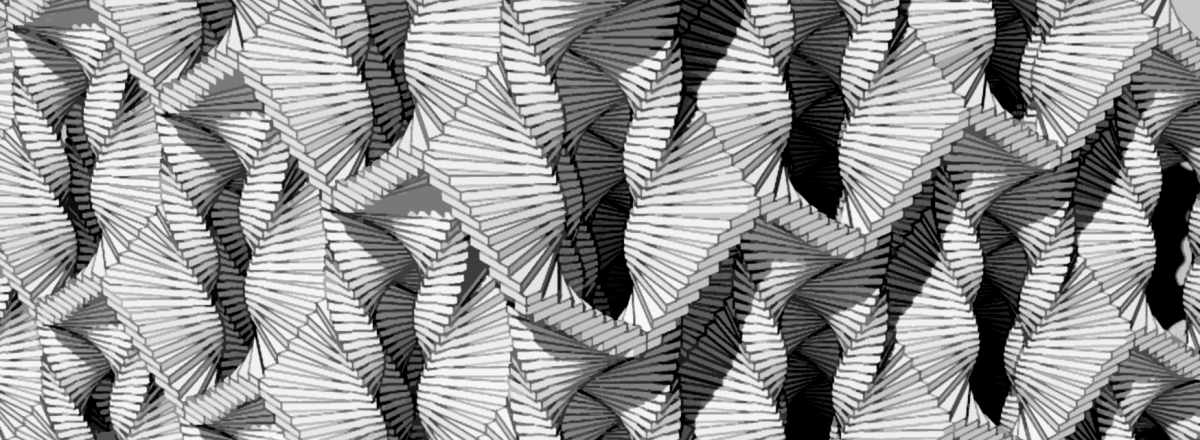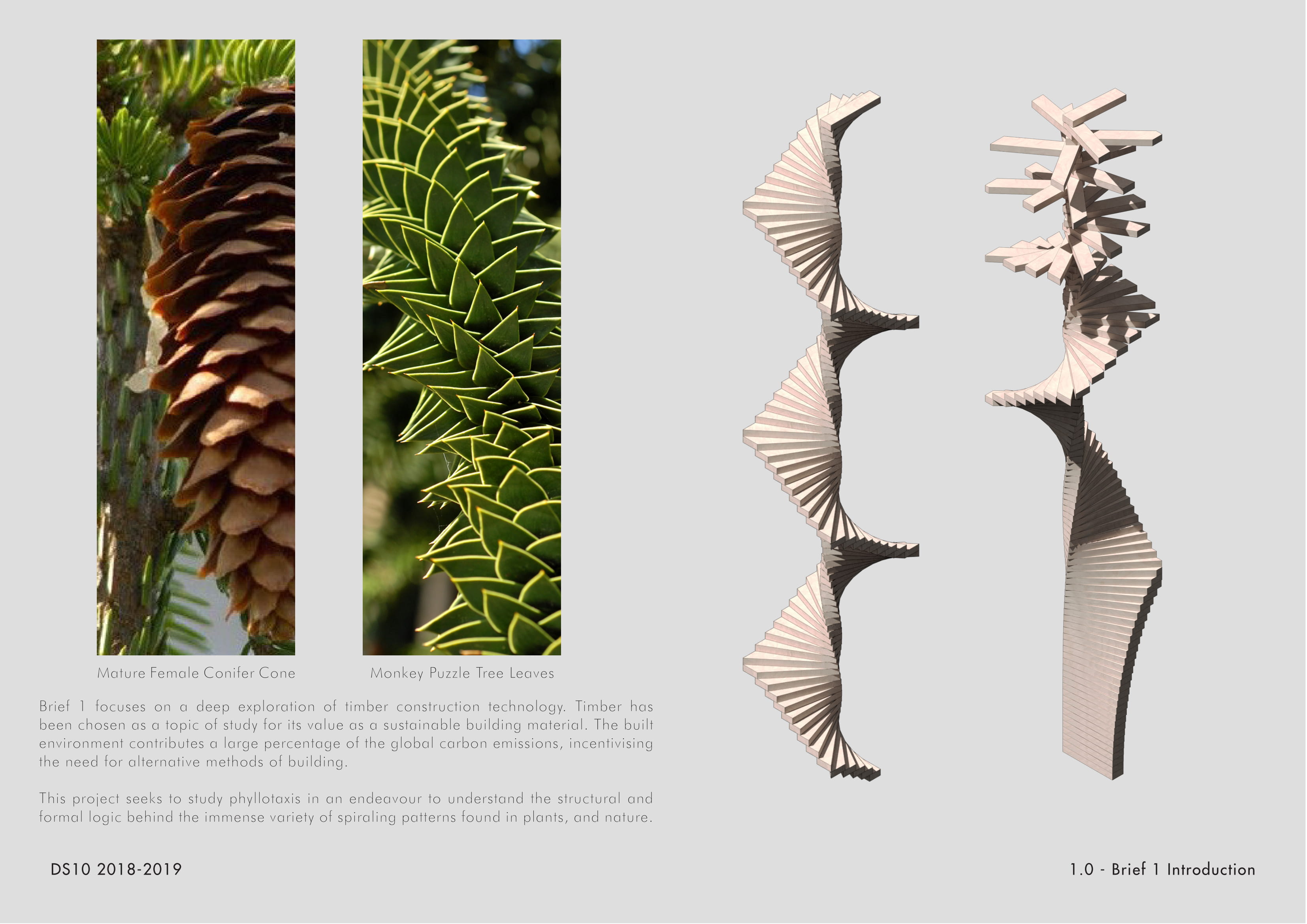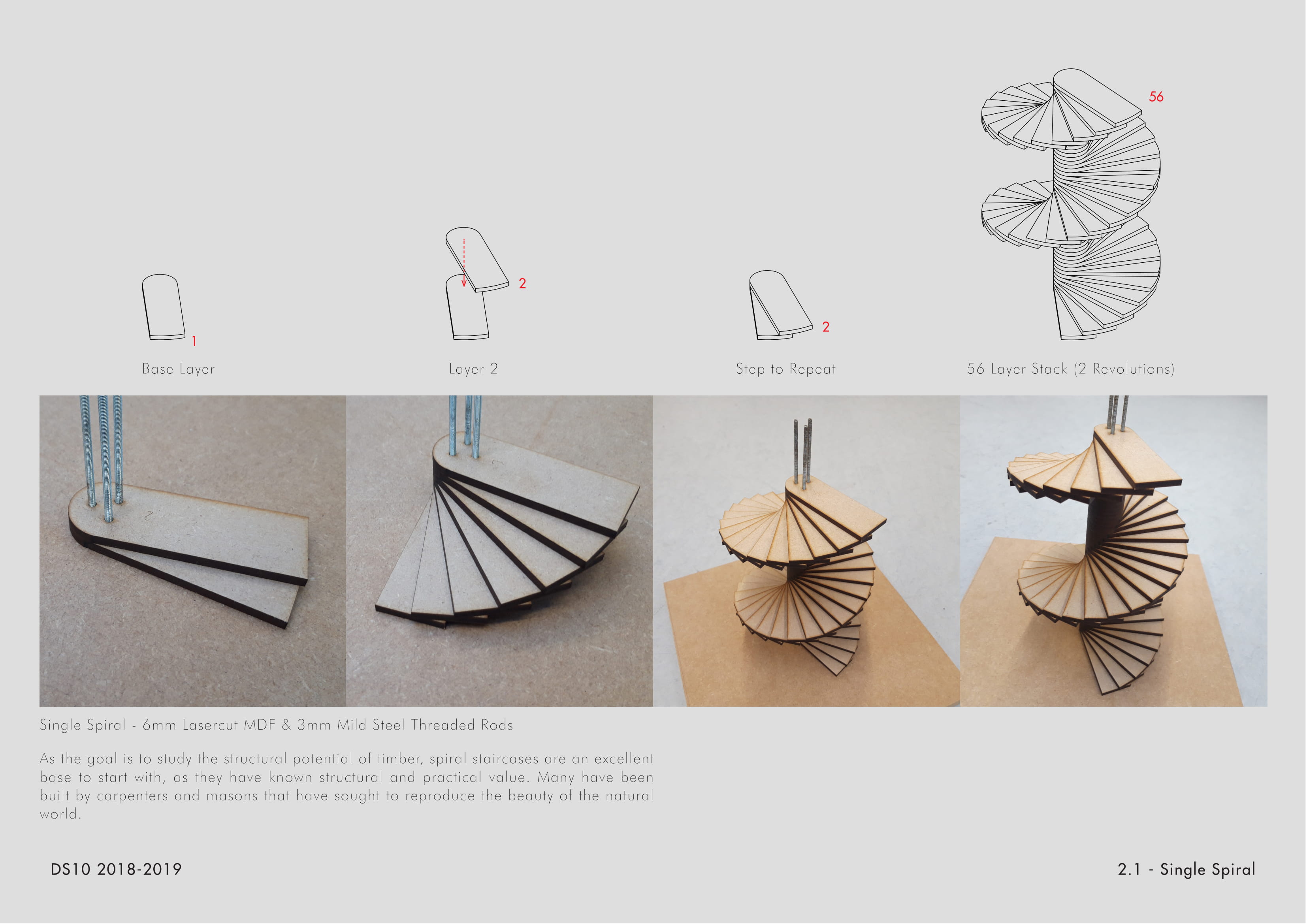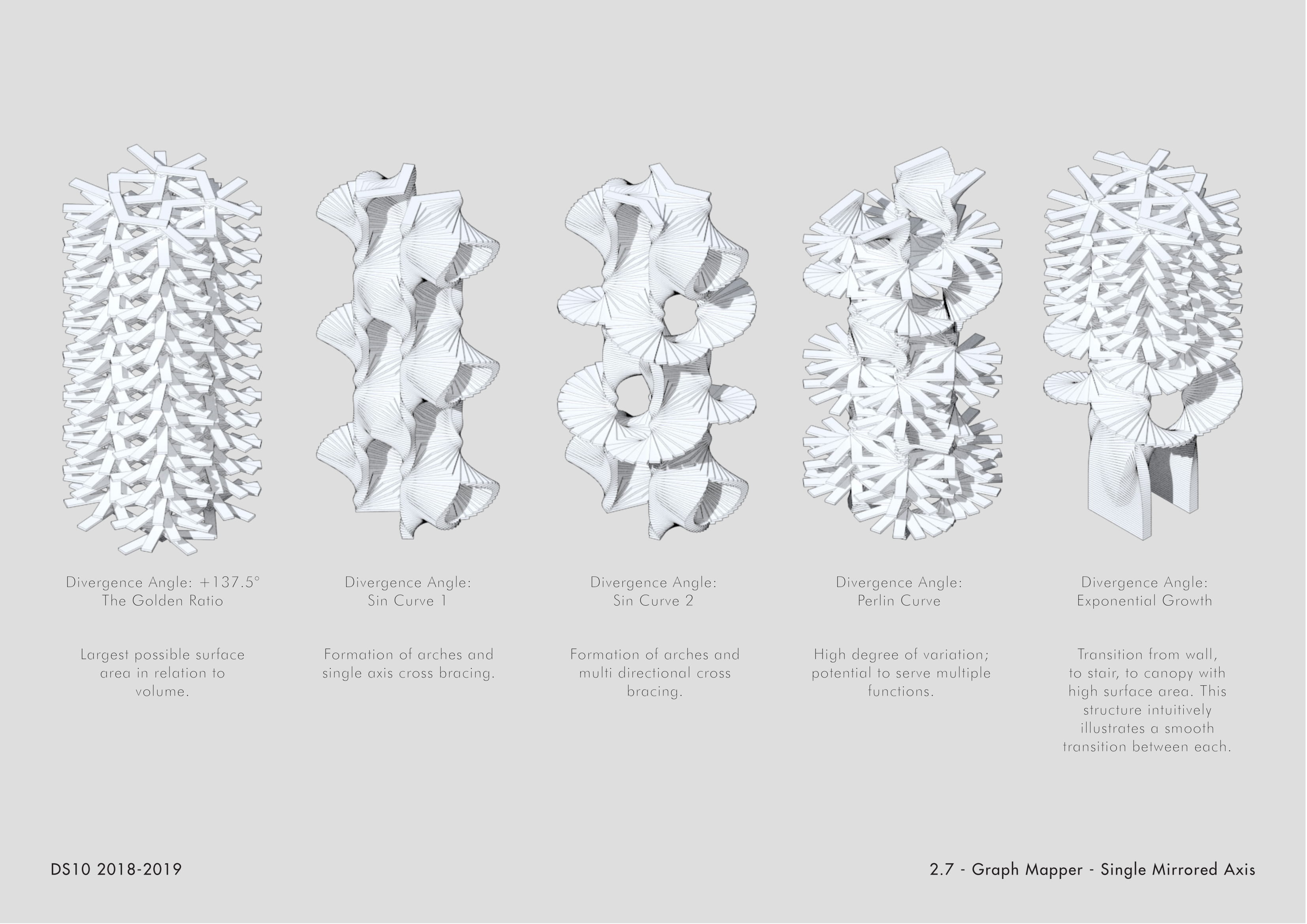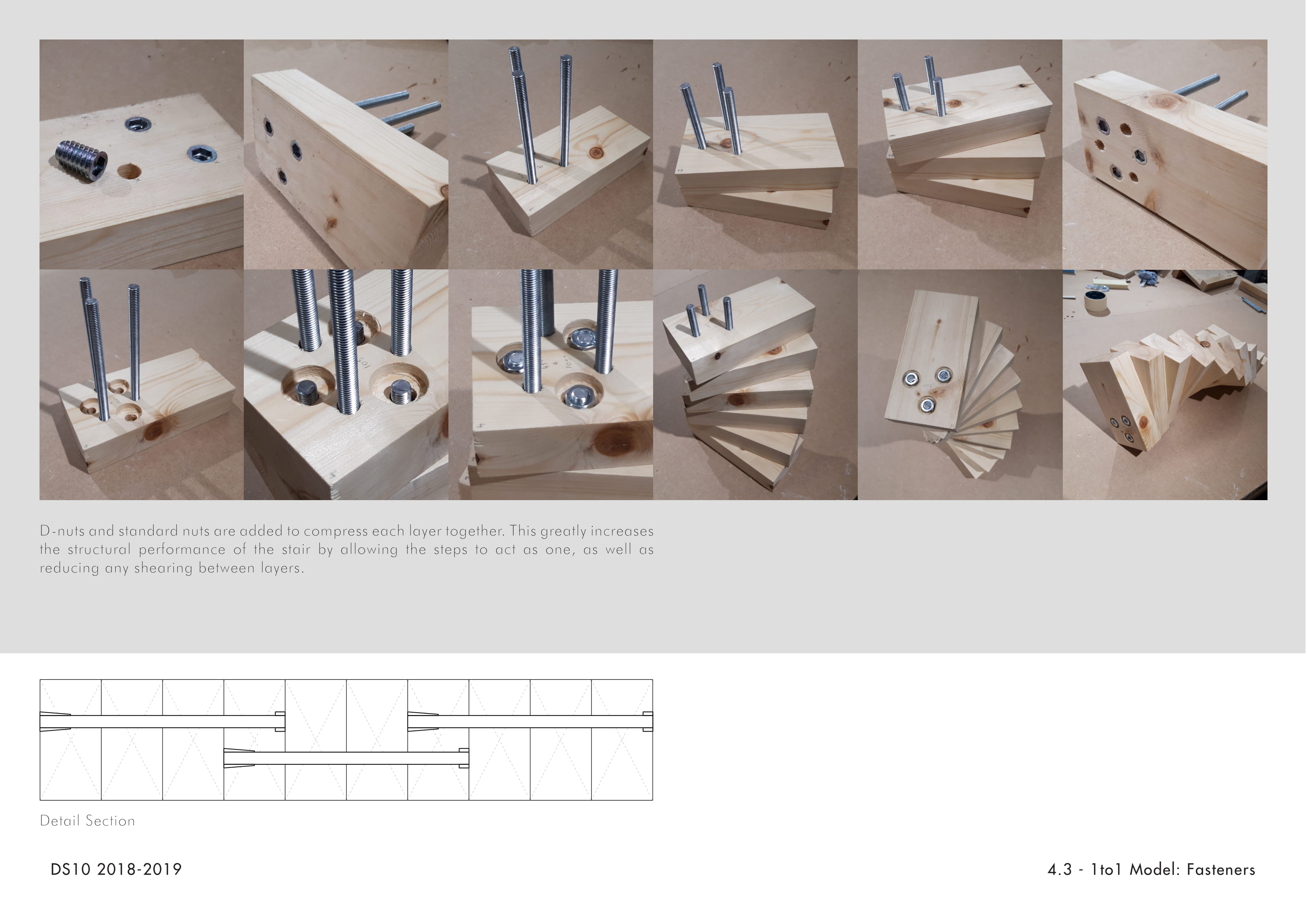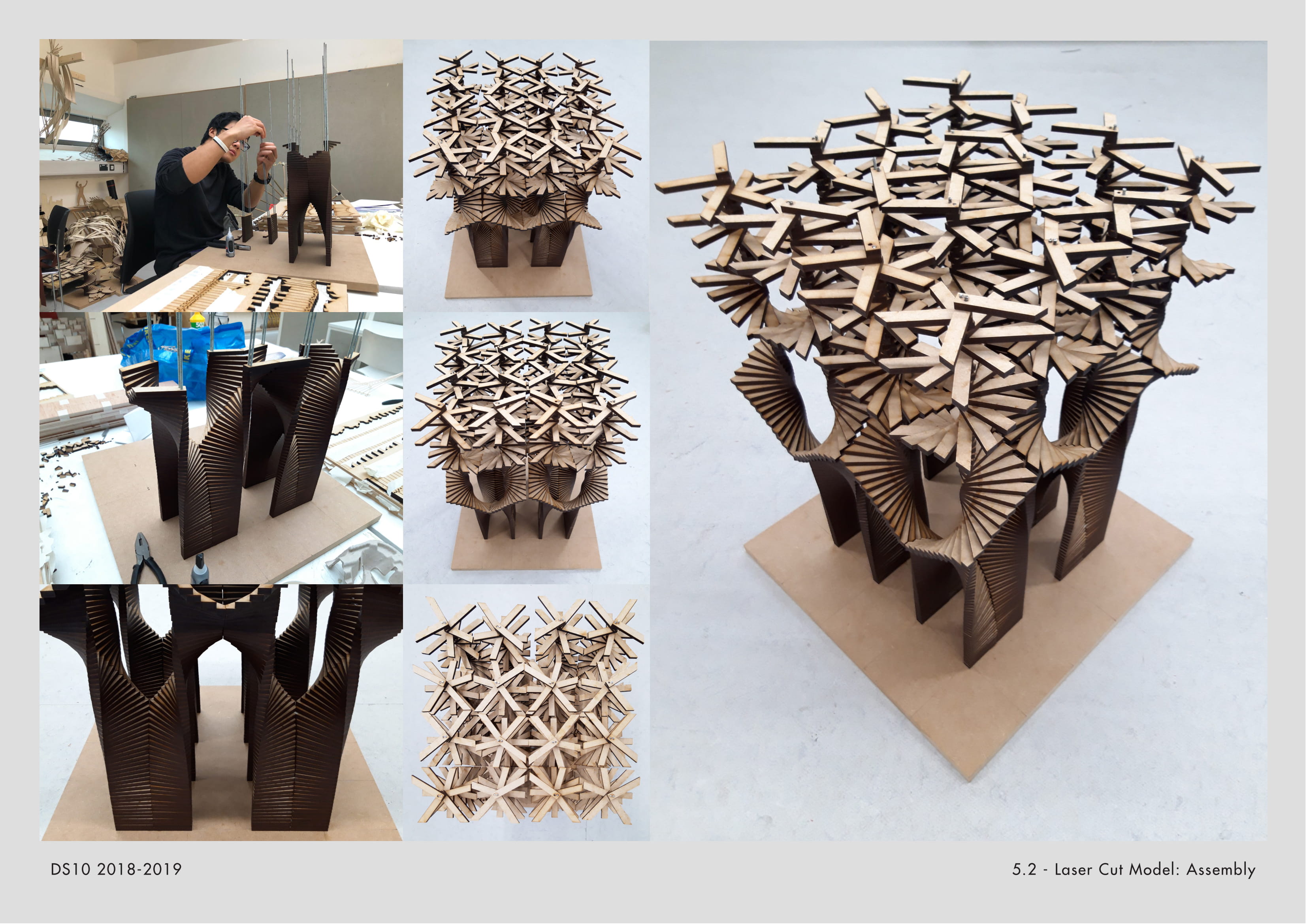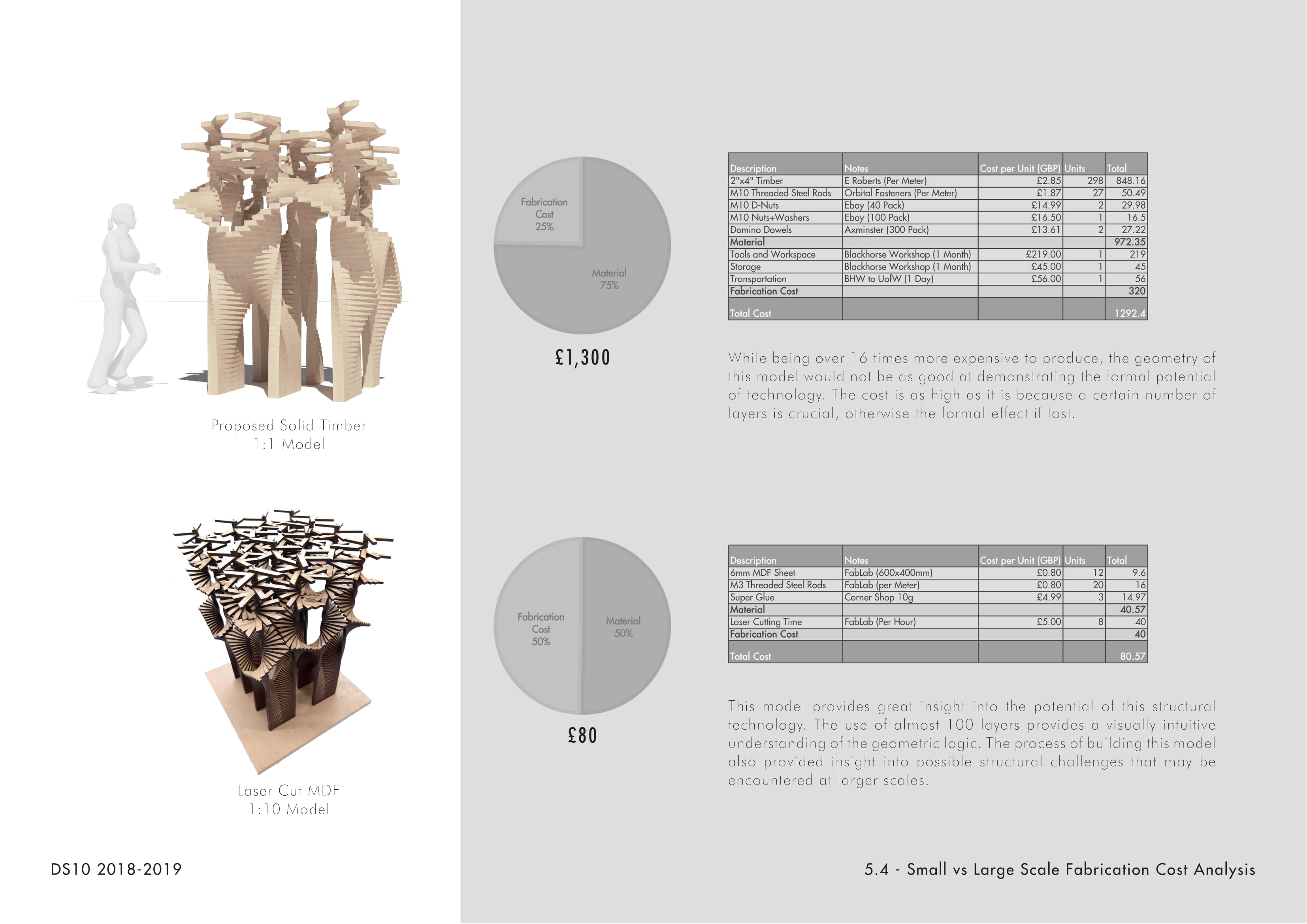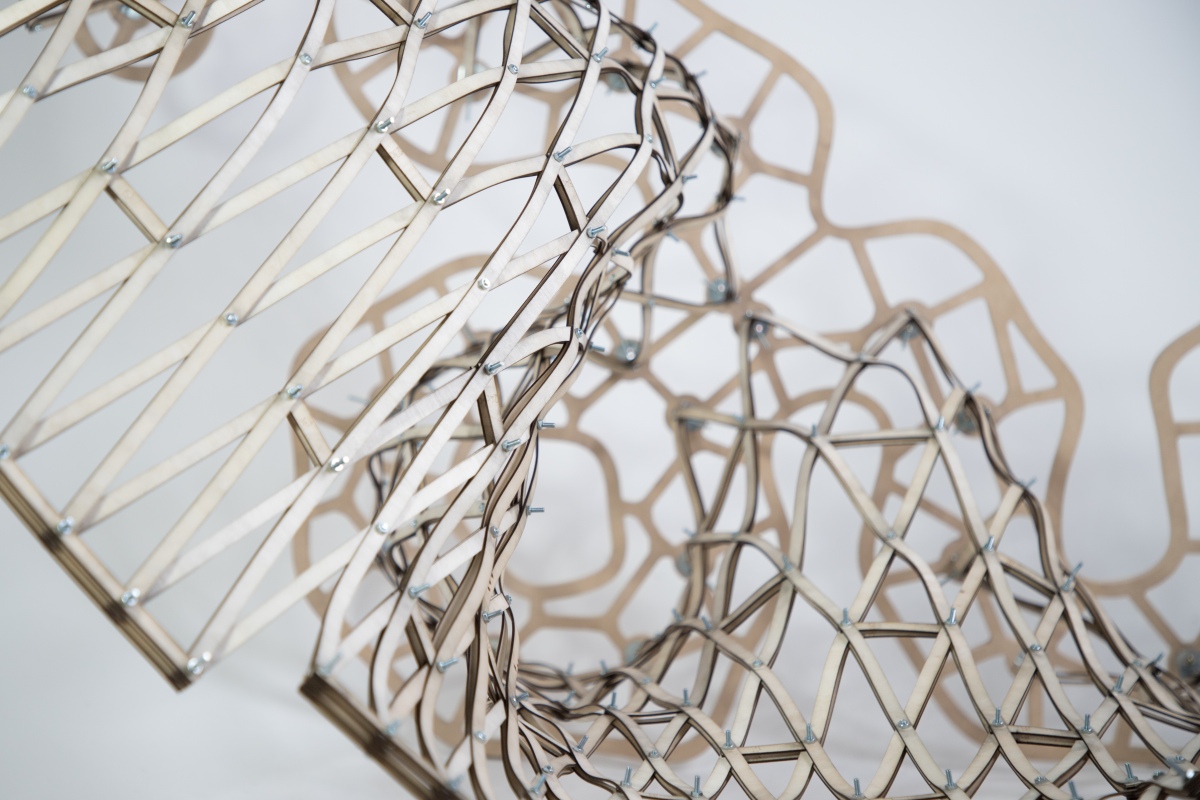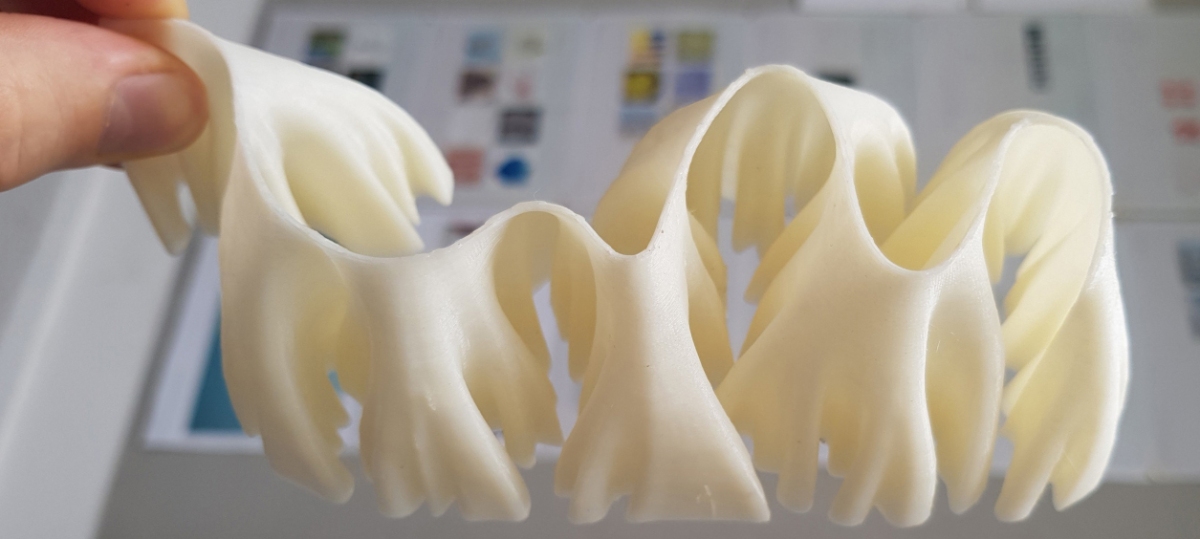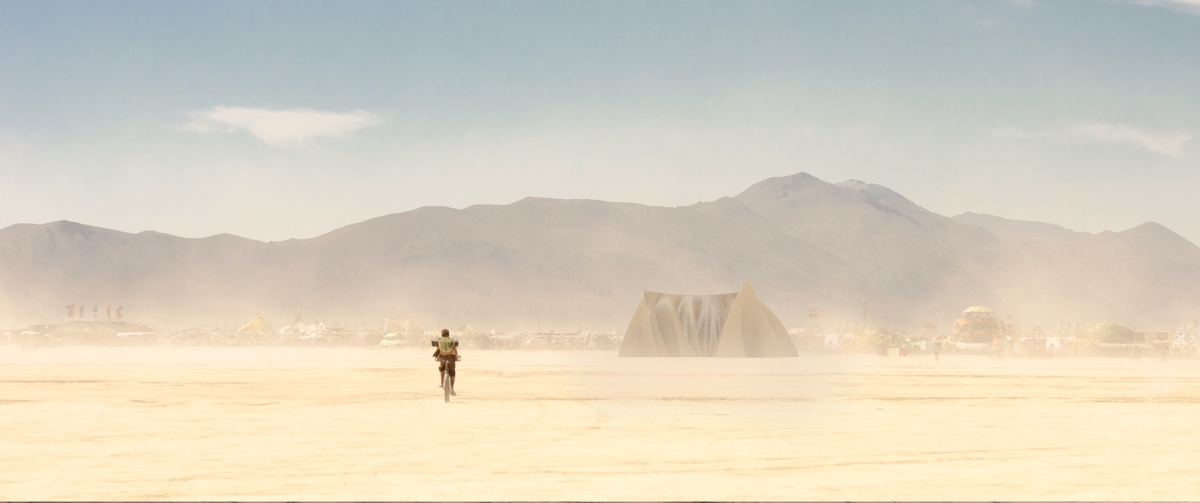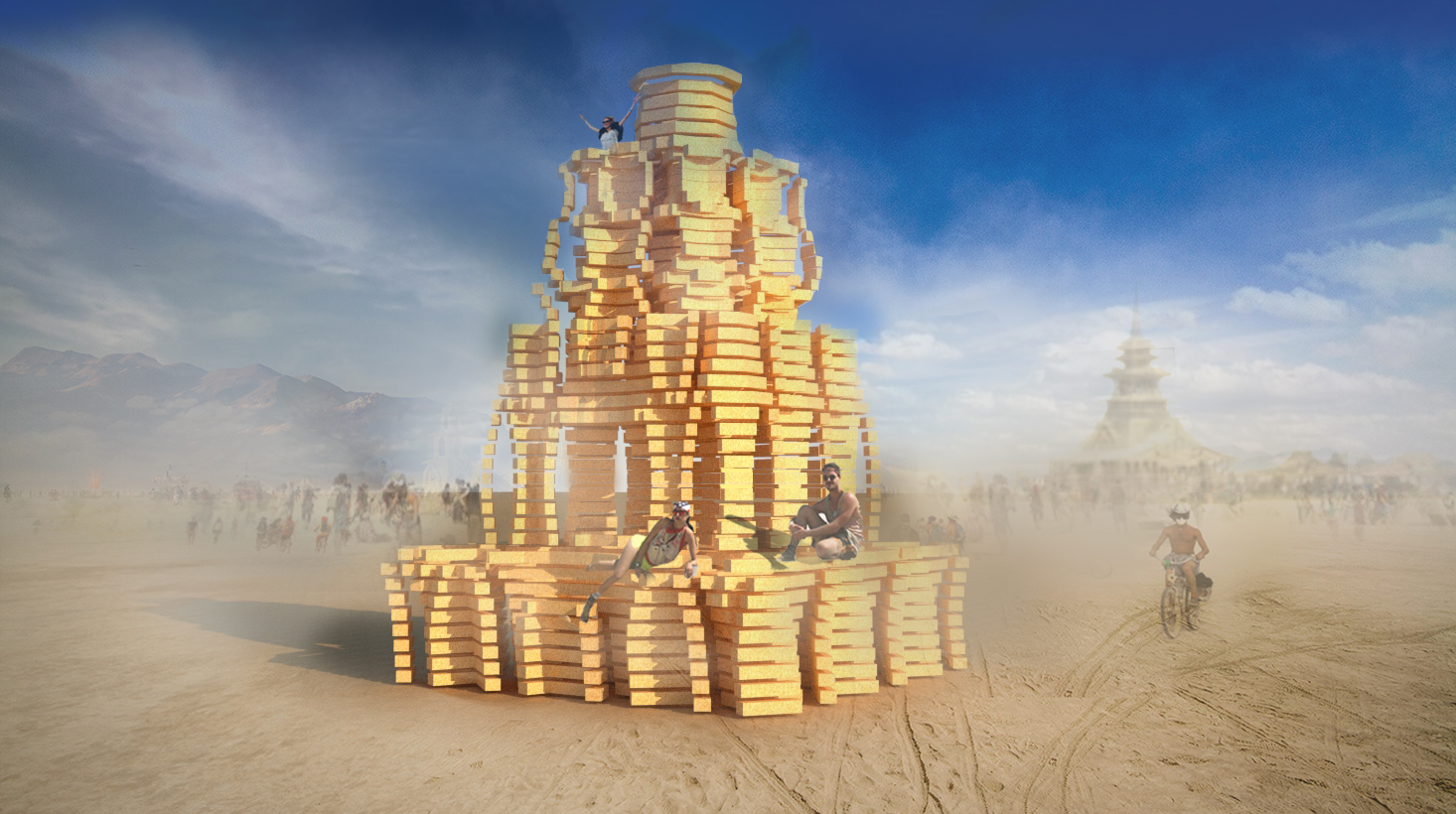Category: Fabrication
Bend Active
The initial aspiration of the project was to produce a method of simplifying the construction of the 5 regular platonic solids (Tetrahedron, Cube, Octahedron, Dodecahedron and Icosahedron) using only bend active timber and simple bolted connections, eliminating the need for complex nodal connections as seen in geodesic dome construction and other compound angle connections.
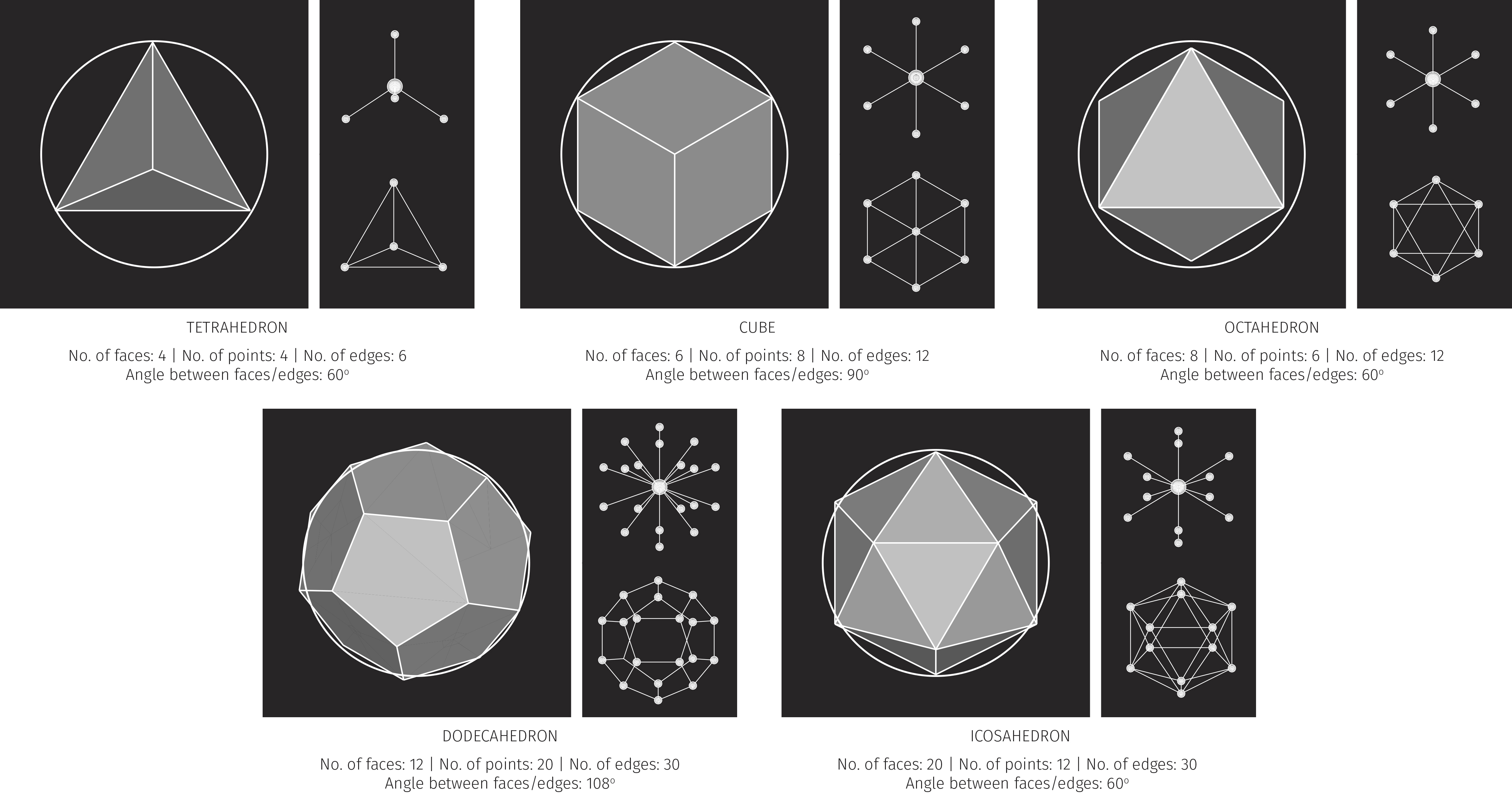
Bend active timber being the main research topic, the structural capabilities and bending radii of plywood were physically tested incorporating the several thicknesses and crucially the direction of the bend either being parallel or perpendicular to the grain, resulting in an informative results matrix.
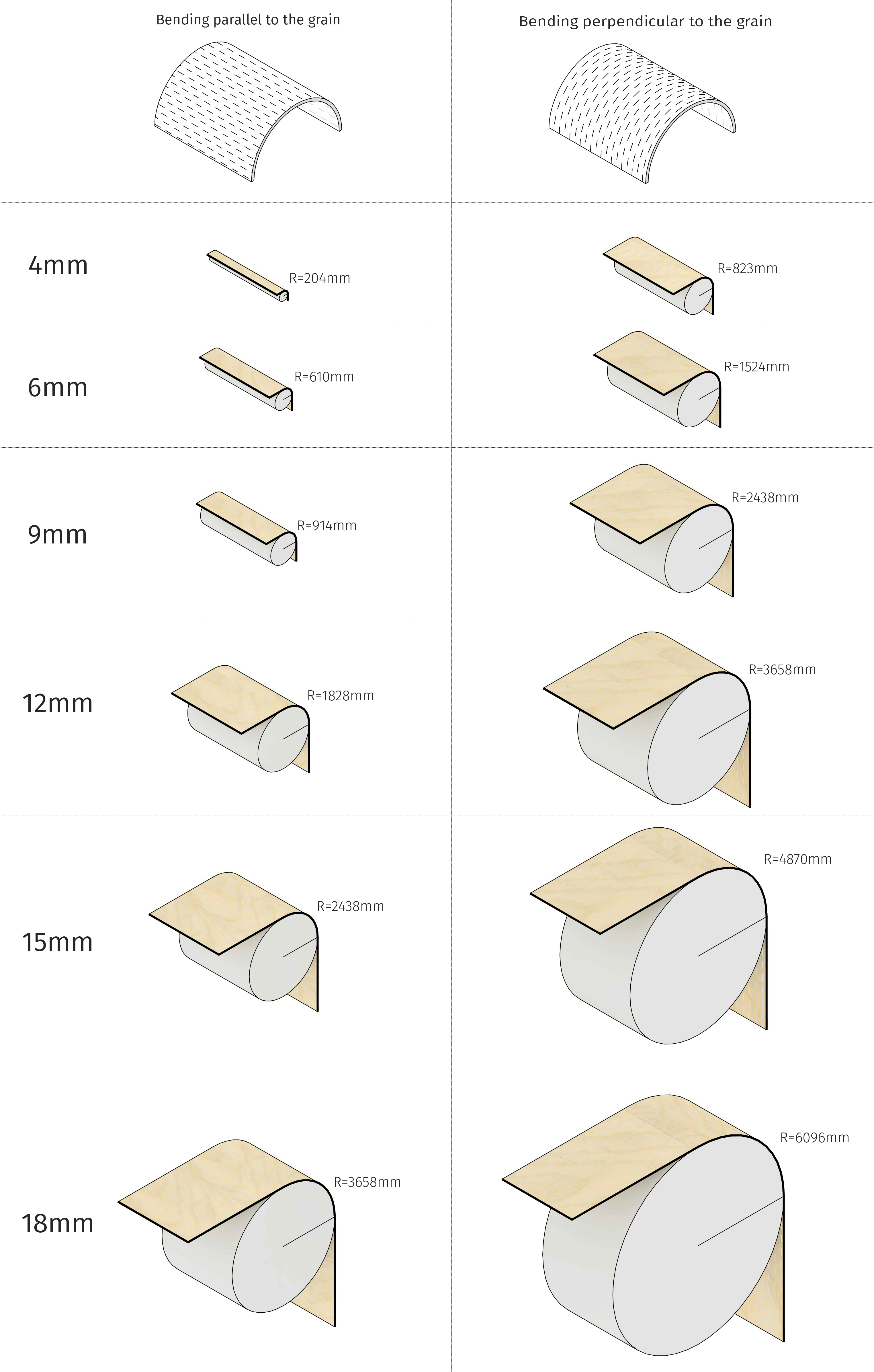
Digital explorations were undertaken for each of the platonic solids creating various sized volumetric frame structures. The resultant sizes were due to each component being constrained to fit on a standard 2440x1220mm plywood sheet and the resultant bending radius
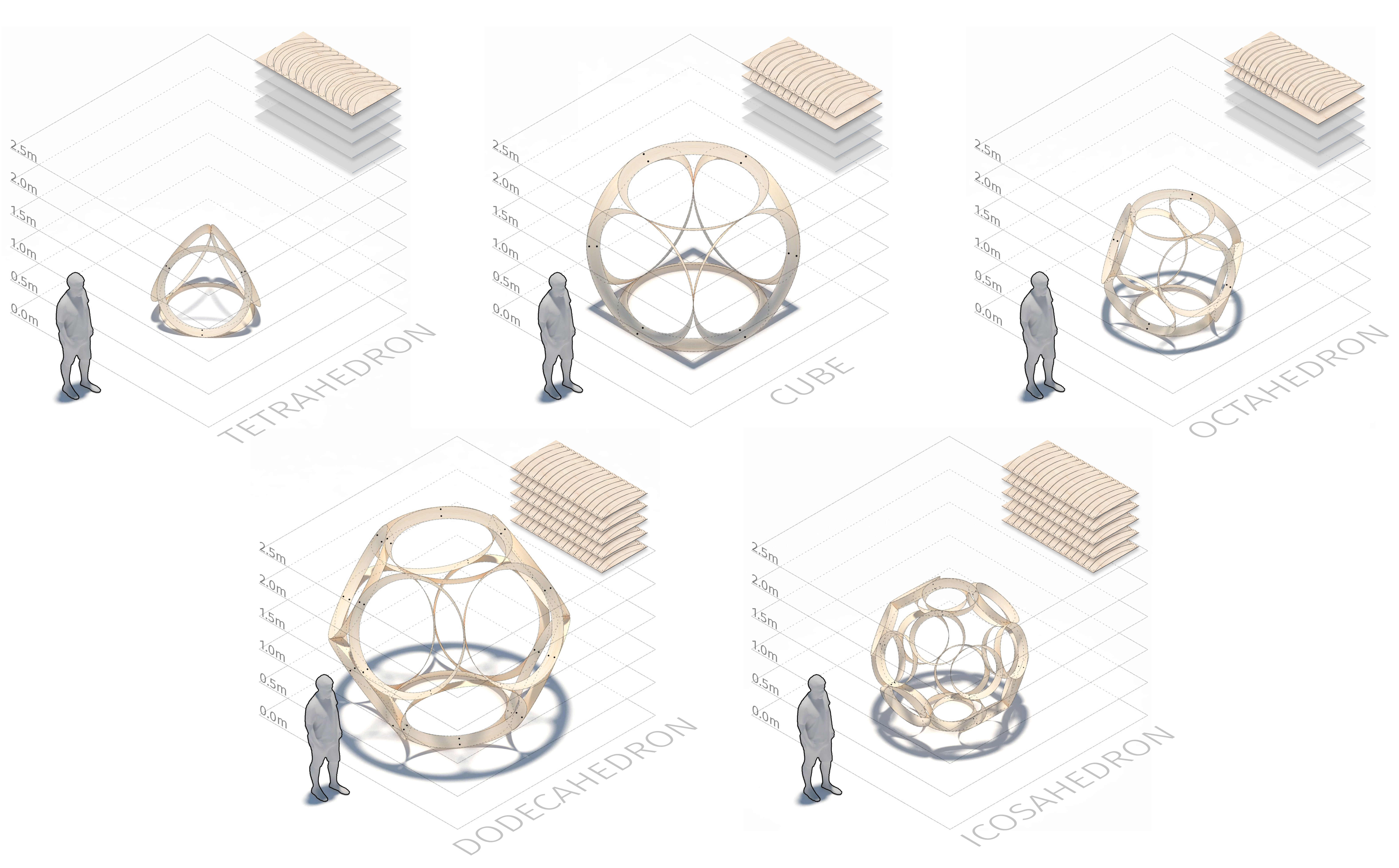
Following physical investigations of each, the cube was taken forward as it was; more efficient in terms of material usage, easier method of assembly comparatively and unintentionally produced a deployable mechanism similar to the famous Hoberman’s sphere.
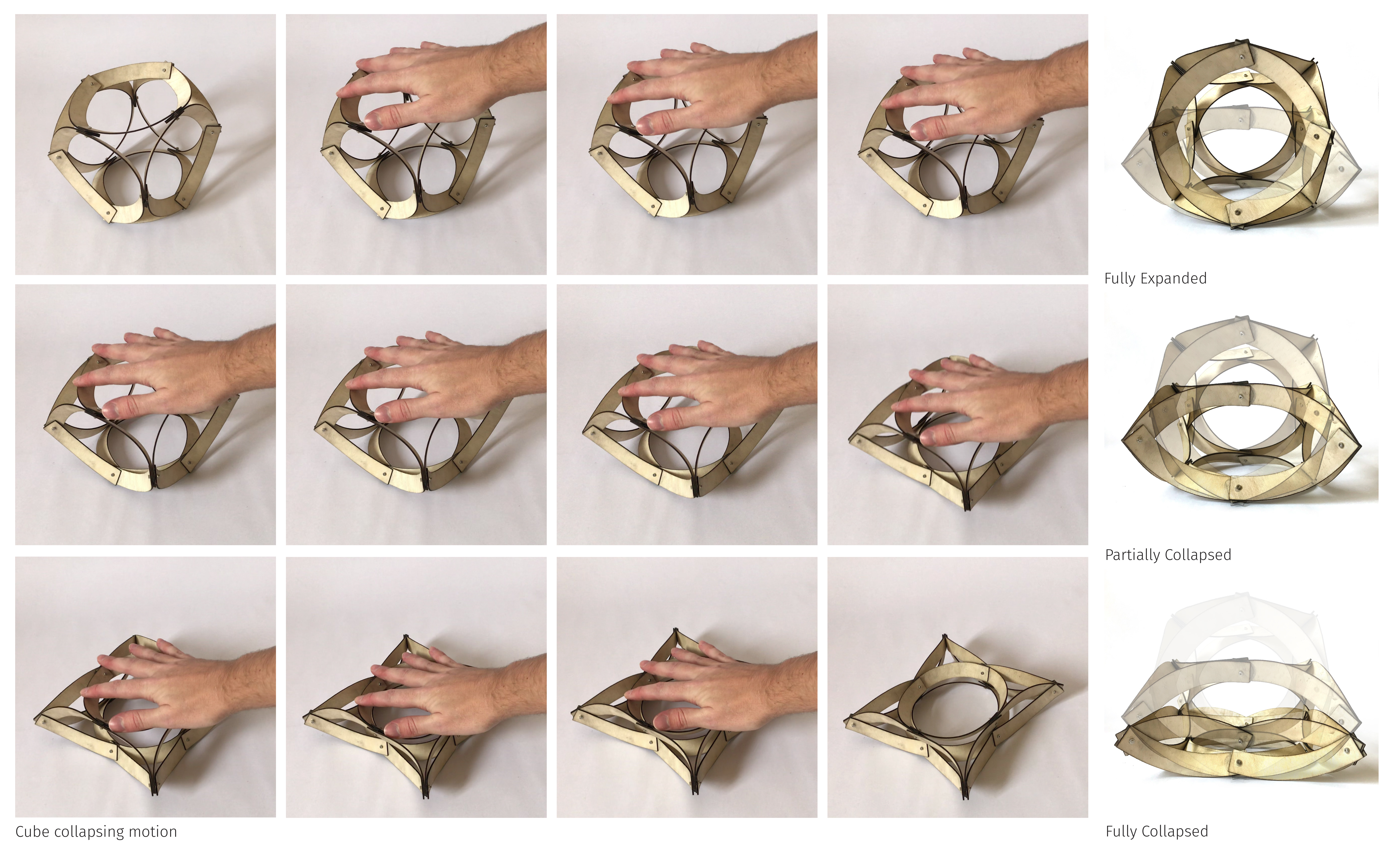
The system utilizes identical components meaning the fabrication process can be quickly and easily performed using a CNC machine, with assembling being intuitive, not requiring different parts or specialised assembly instructions. The components were cut using my own CNC and were then simply assembled by hand using bolted connections to create the skeletal frame. Assembly was extremely quick, from flat components to finished volumetric module taking only 20 minutes.
The pre-fabricated modules can then be replicated and scaled, to suit various habitable typologies a community would need or can be used individually as a deployable shelter for the homeless/emergency relief.
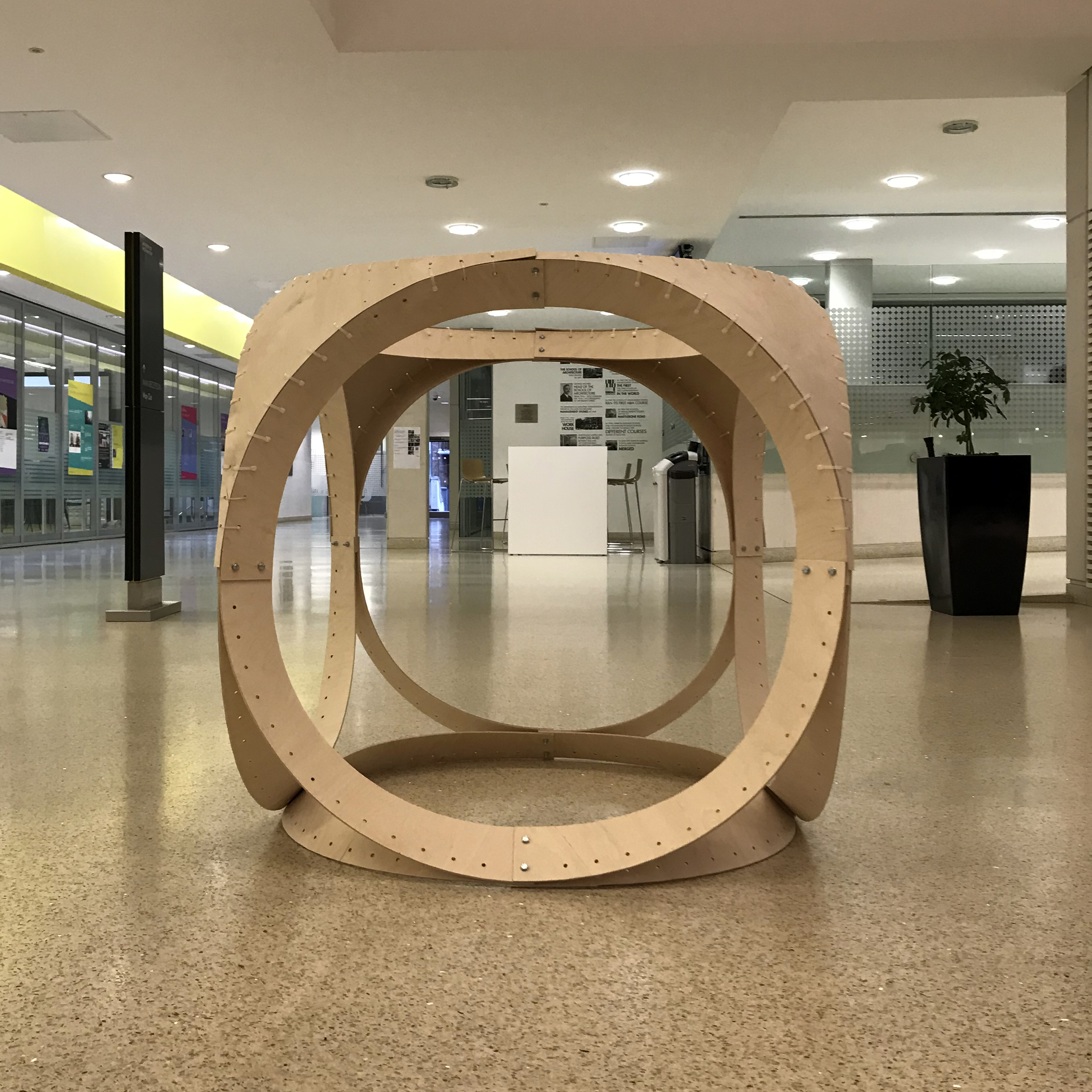
The Nature of Gridshell Form Finding
Grids, shells, and how they, in conjunction with the study of the natural world, can help us develop increasingly complex structural geometry.
Foreword
This post is the third installment of sort of trilogy, after Shapes, Fractals, Time & the Dimensions they Belong to, and Developing Space-Filling Fractals. While it’s not important to have read either of those posts to follow this one, I do think it adds a certain level of depth and continuity.
Regarding my previous entries, it can be difficult to see how any of this has to do with architecture. In fact I know a few people who think studying fractals is pointless.
Admittedly I often struggle to explain to people what fractals are, let alone how they can influence the way buildings look. However, I believe that this post really sheds light on how these kinds of studies may directly influence and enhance our understanding (and perhaps even the future) of our built environment.
On a separate note, I heard that a member of the architectural academia said “forget biomimicry, it doesn’t work.”
Firstly, I’m pretty sure Frei Otto would be rolling over in his grave.
Secondly, if someone thinks that biomimicry is useless, it’s because they don’t really understand what biomimicry is. And I think the same can be said regarding the study of fractals. They are closely related fields of study, and I wholeheartedly believe they are fertile grounds for architectural marvels to come.
7.0 Introduction to Shells
As far as classification goes, shells generally fall under the category of two-dimensional shapes. They are defined by a curved surface, where the material is thin in the direction perpendicular to the surface. However, assigning a dimension to certain shells can be tricky, since it kinda depends on how zoomed in you are.
A strainer is a good example of this – a two-dimensional gridshell. But if you zoom in, it is comprised of a series of woven, one-dimensional wires. And if you zoom in even further, you see that each wire is of course comprised of a certain volume of metal.
This is a property shared with many fractals, where their dimension can appear different depending on the level of magnification. And while there’s an infinite variety of possible shells, they are (for the most part) categorizable.
7.1 – Single Curved Surfaces
Analytic geometry is created in relation to Cartesian planes, using mathematical equations and a coordinate systems. Synthetic geometry is essentially free-form geometry (that isn’t defined by coordinates or equations), with the use of a variety of curves called splines. The following shapes were created via Synthetic geometry, where we’re calling our splines ‘u’ and ‘v.’
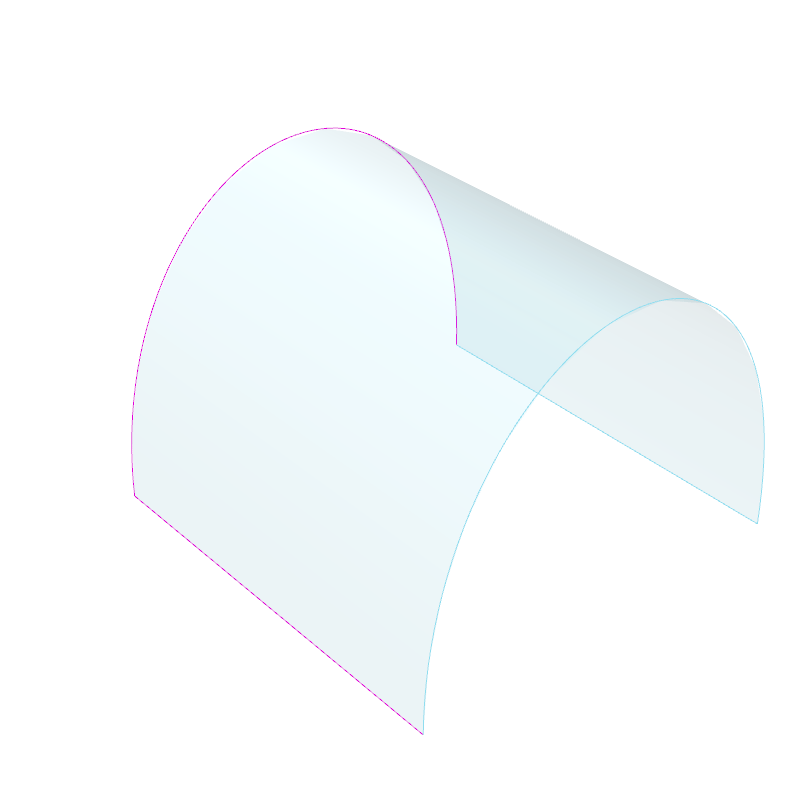
These curves highlight each dimension of the two-dimensional surface. In this case only one of the two ‘curves’ is actually curved, making this shape developable. This means that if, for example, it was made of paper, you could flatten it completely.
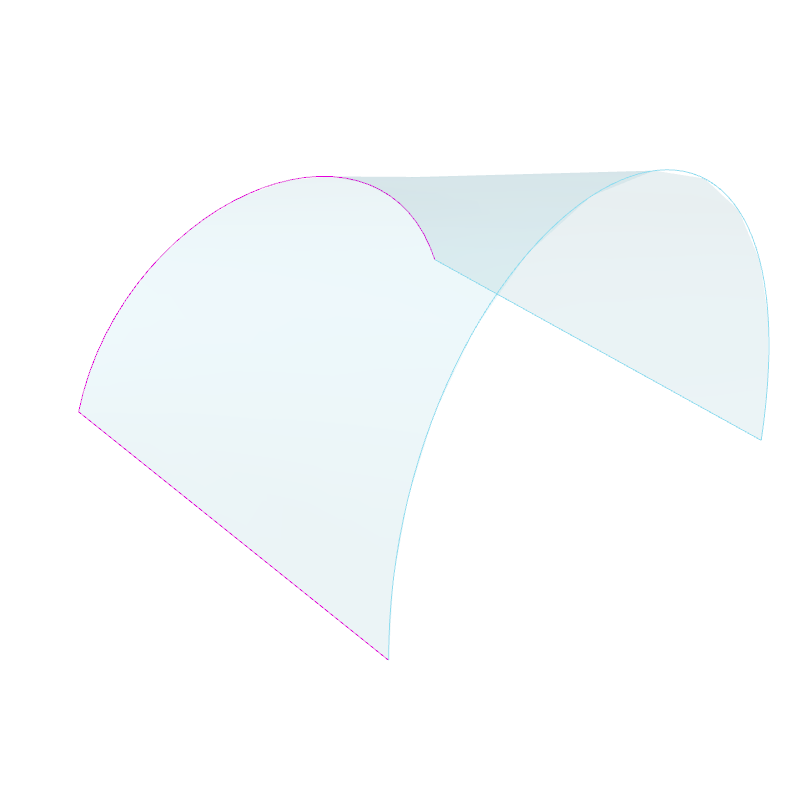
Uniclastic: Conoid (Conical paraboloid)
In this case, one of them grows in length, but the other still remains straight. Since one of the dimensions remains straight, it’s still a single curved surface – capable of being flattened without changing the area. Singly curved surfaced may also be referred to as uniclastic or monoclastic.
7.2 – Double Curved Surfaces
These can be classified as synclastic or anticlastic, and are non-developable surfaces. If made of paper, you could not flatten them without tearing, folding or crumpling them.
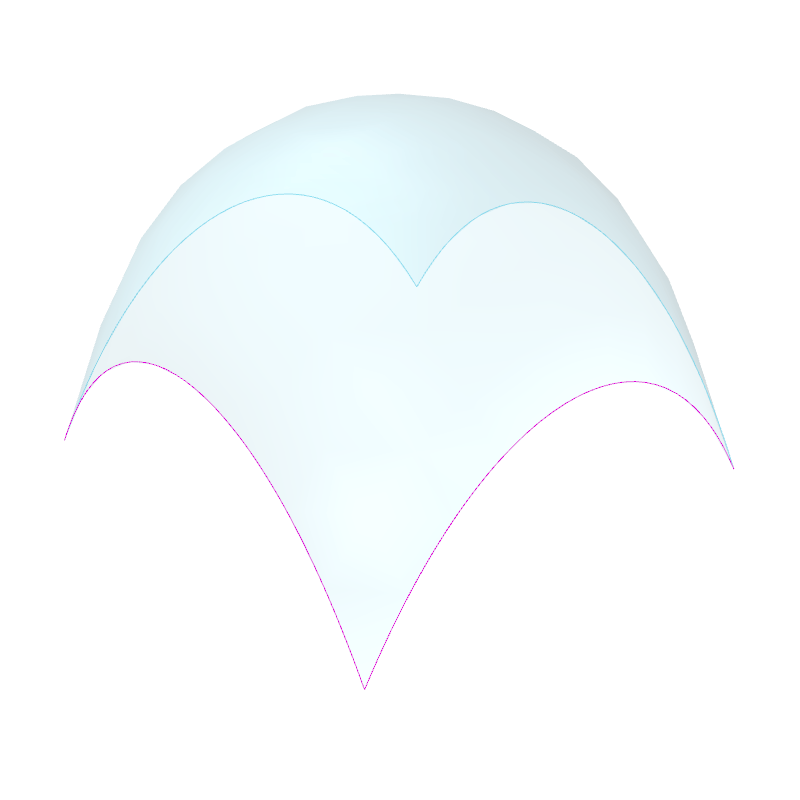
In this case, both curves happen to be identical, but what’s important is that both dimensions are curving in the same direction. In this orientation, the dome is also under compression everywhere.
The surface of the earth is double curved, synclastic – non-developable. “The surface of a sphere cannot be represented on a plane without distortion,” a topic explored by Michael Stevens: https://www.youtube.com/watch?v=2lR7s1Y6Zig
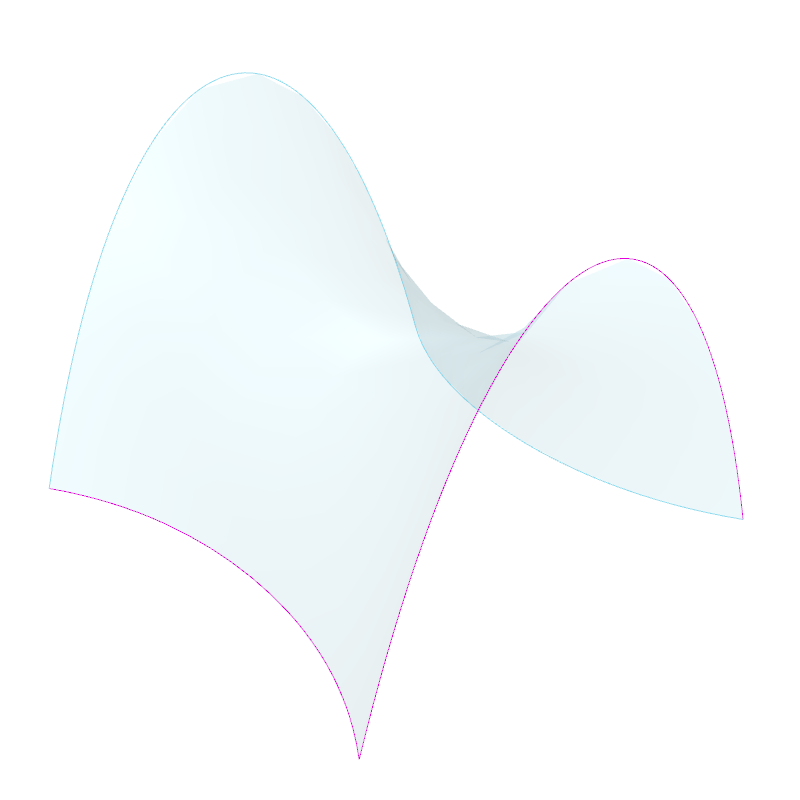
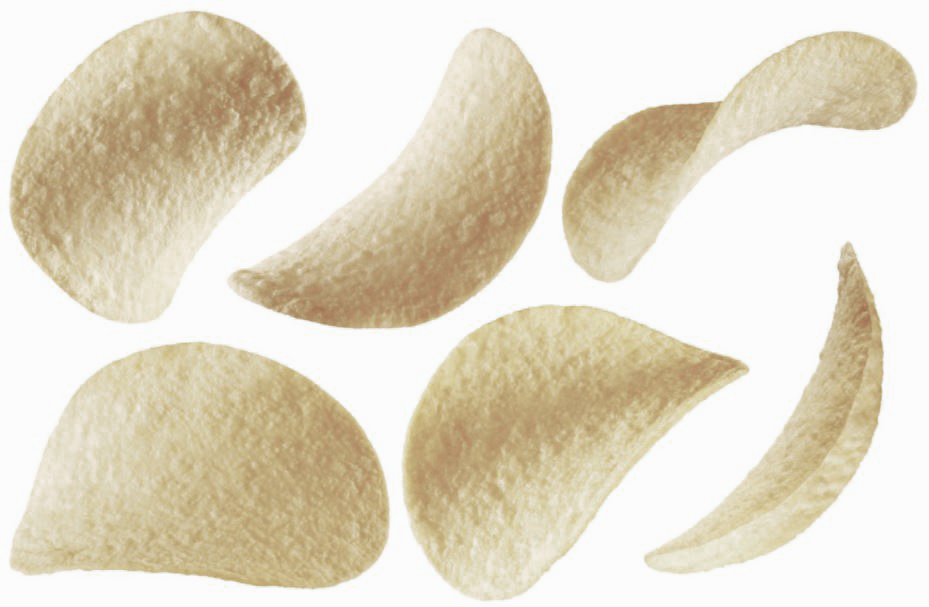
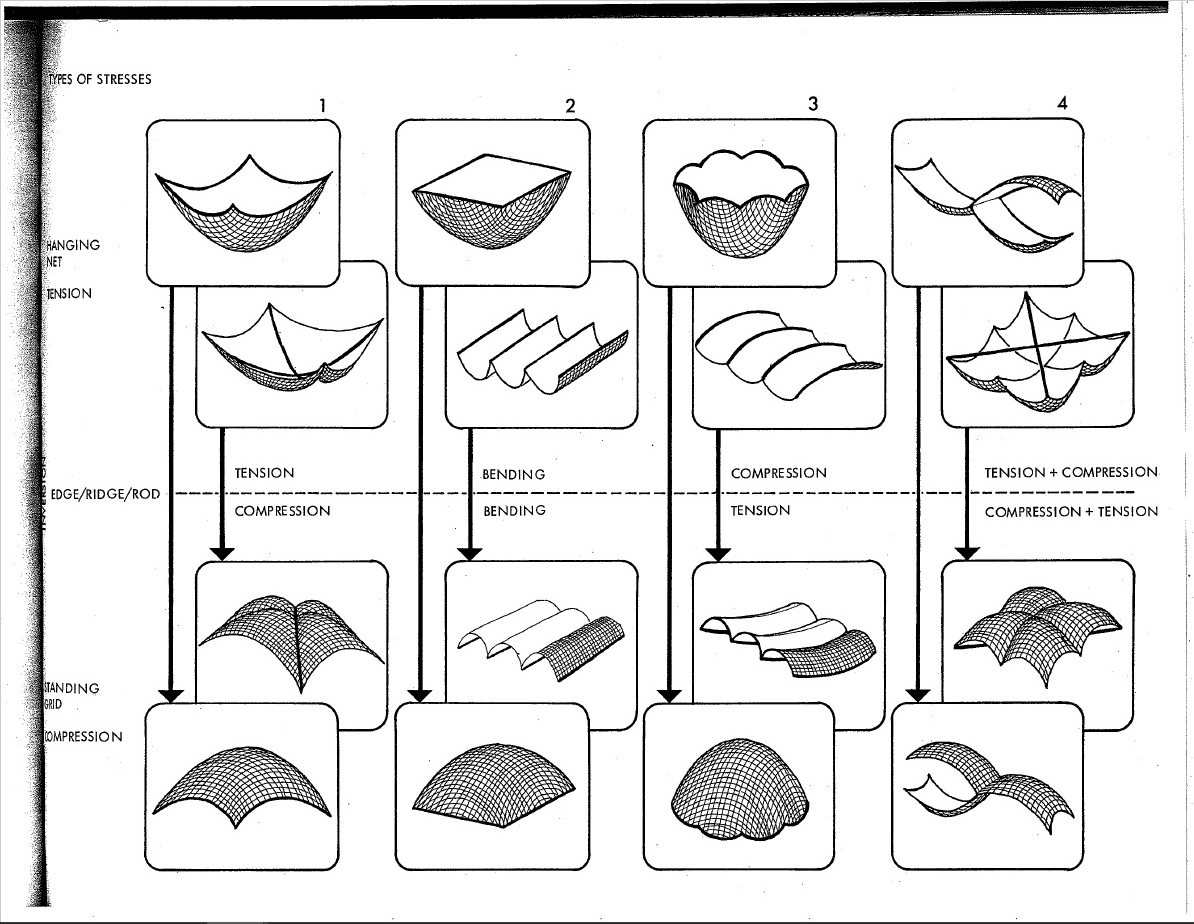
7.3 – Translation vs Revolution
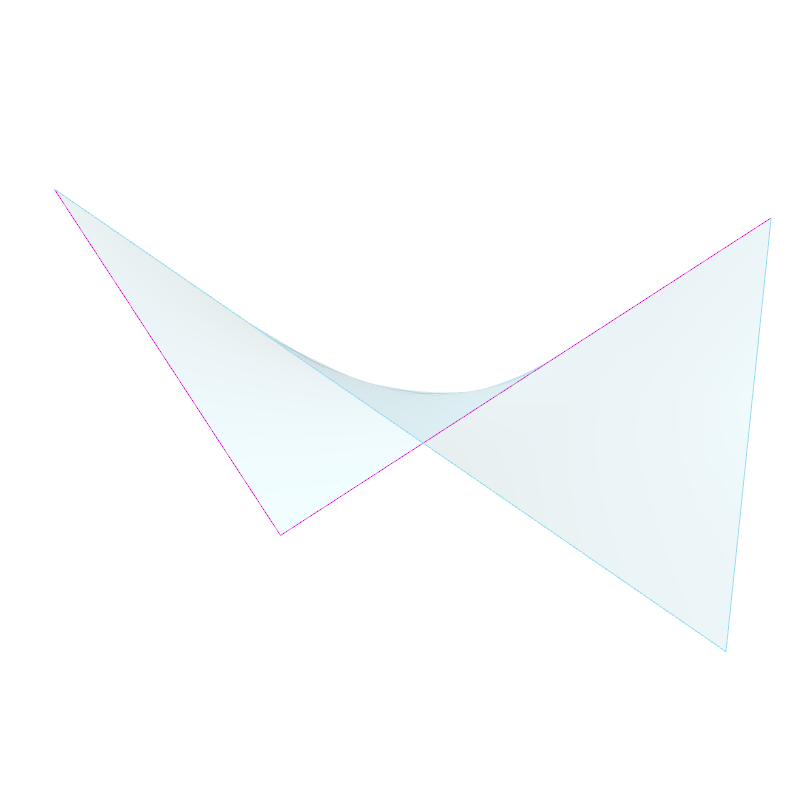
This shape was achieved by sweeping a straight line over a straight path at one end, and another straight path at the other. This will work as long as both rails are not parallel. Although I find this shape perplexing; it’s double curvature that you can create with straight lines, yet non-developable, and I can’t explain it..
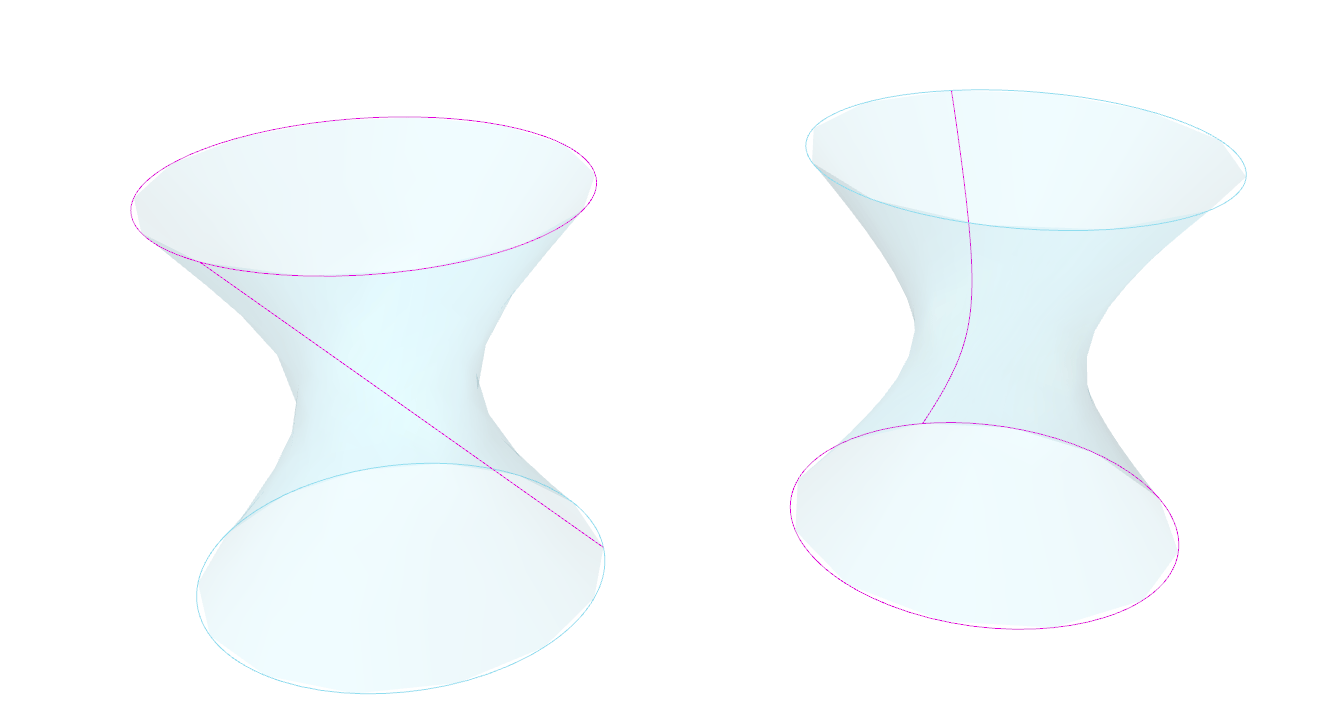
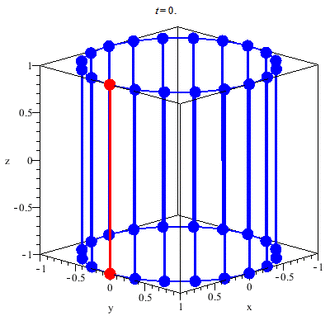
The hyperboloid has been a popular design choice for (especially nuclear cooling) towers. It has excellent tensile and compressive properties, and can be built with straight members. This makes it relatively cheap and easy to fabricate relative to it’s size and performance.
8.0 Geodesic Curves
These are singly curved curves, although that does sound confusing. A simple way to understand what geodesic curves are, is to give them a width. As previously explored, we know that curves can inhabit, and fill, two-dimensional space. However, you can’t really observe the twists and turns of a shape that has no thickness.
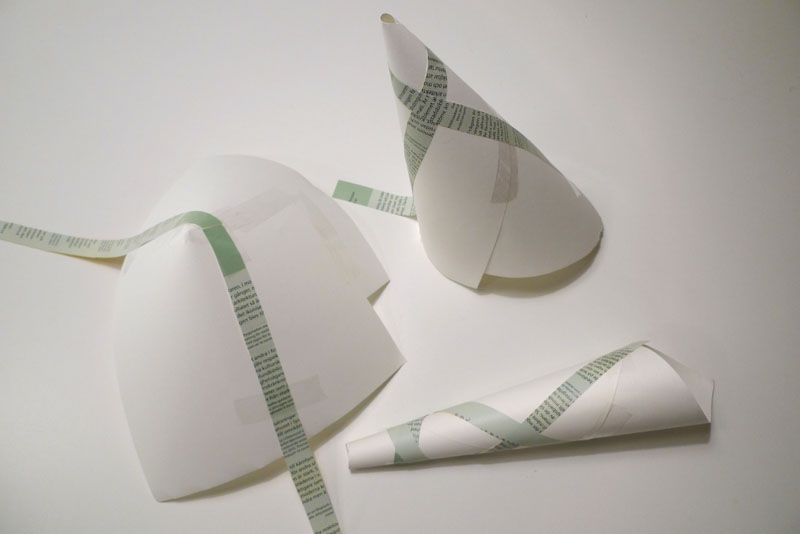
A ribbon is essentially a straight line with thickness, and when used to follow the curvature of a surface (as seen above), the result is a plank line. The term ‘plank line’ can be defined as a line with an given width (like a plank of wood) that passes over a surface and does not curve in the tangential plane, and whose width is always tangential to the surface.
Since one-dimensional curves do have an orientation in digital modeling, geodesic curves can be described as the one-dimensional counterpart to plank lines, and can benefit from the same definition.
The University of Southern California published a paper exploring the topic further: http://papers.cumincad.org/data/works/att/f197.content.pdf
8.1 – Basic Grid Setup
For simplicity, here’s a basic grid set up on a flat plane:
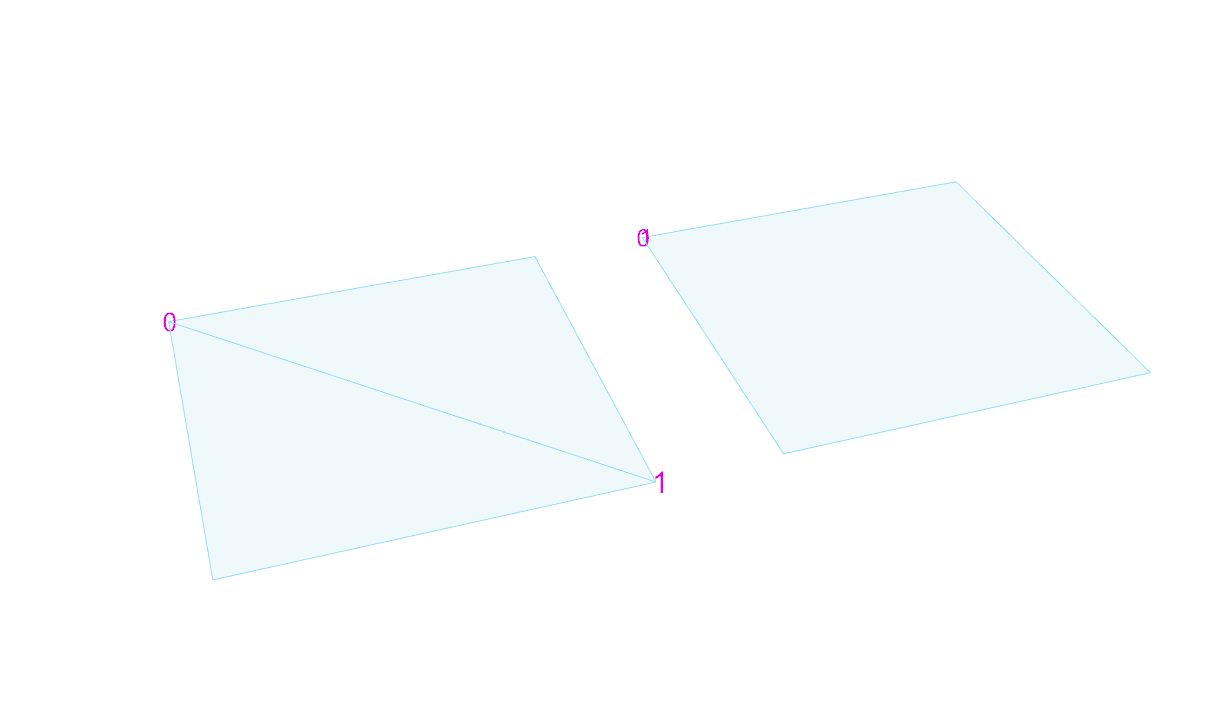
We start by defining two points anywhere along the edge of the surface. Then we find the geodesic curve that joins the pair. Of course it’s trivial in this case, since we’re dealing with a flat surface, but bear with me.
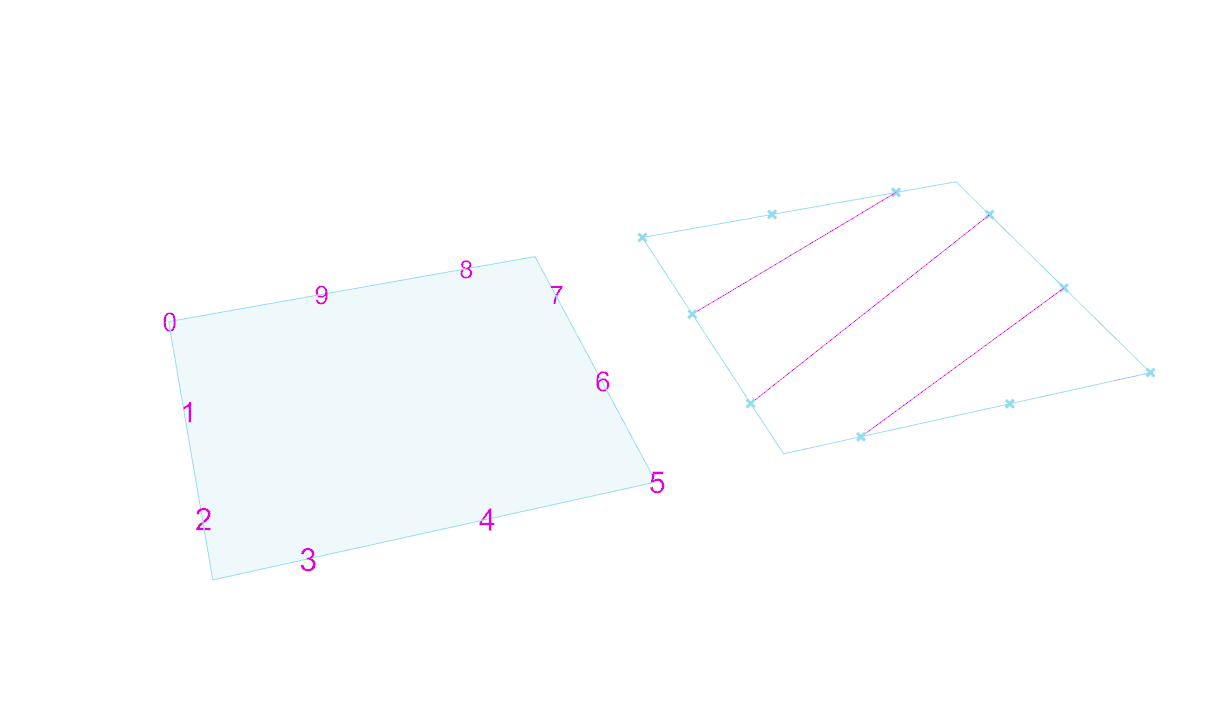
We can keep adding pairs of points along the edge. In this case they’re kept evenly spaced and uncrossing for the sake of a cleaner grid.
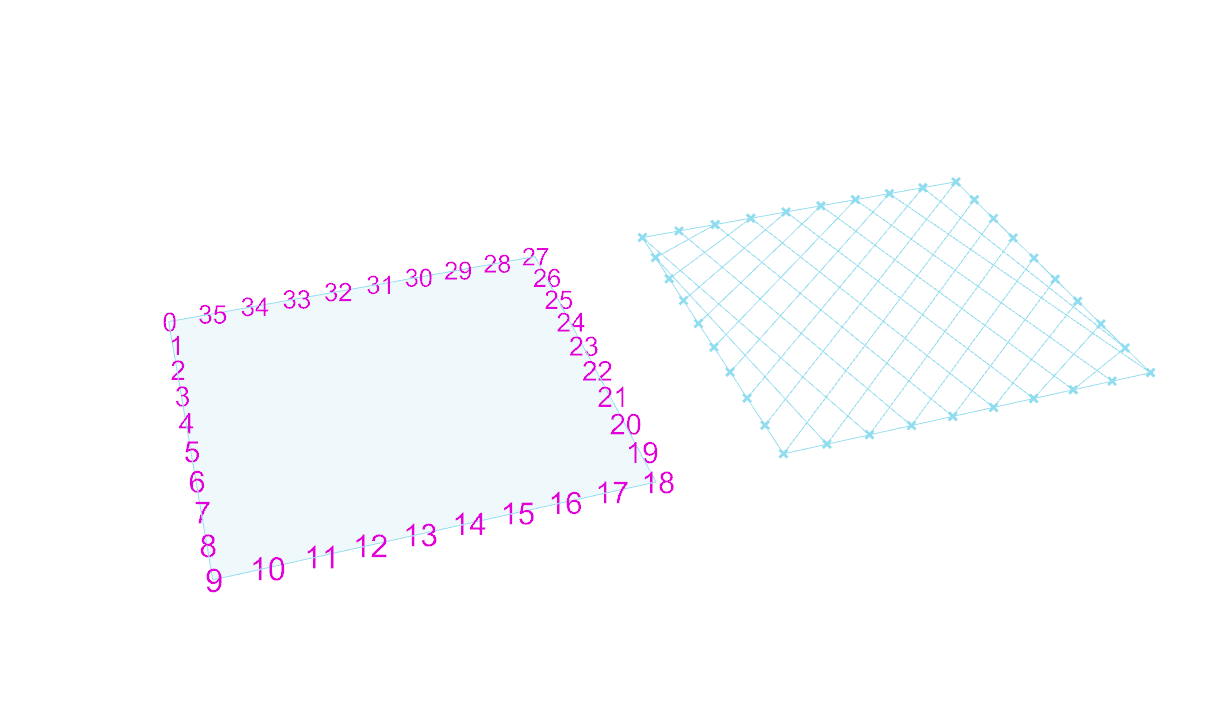
After that, it’s simply a matter of playing with density, as well as adding an additional set of antagonistic curves. For practicality, each set share the same set of base points.
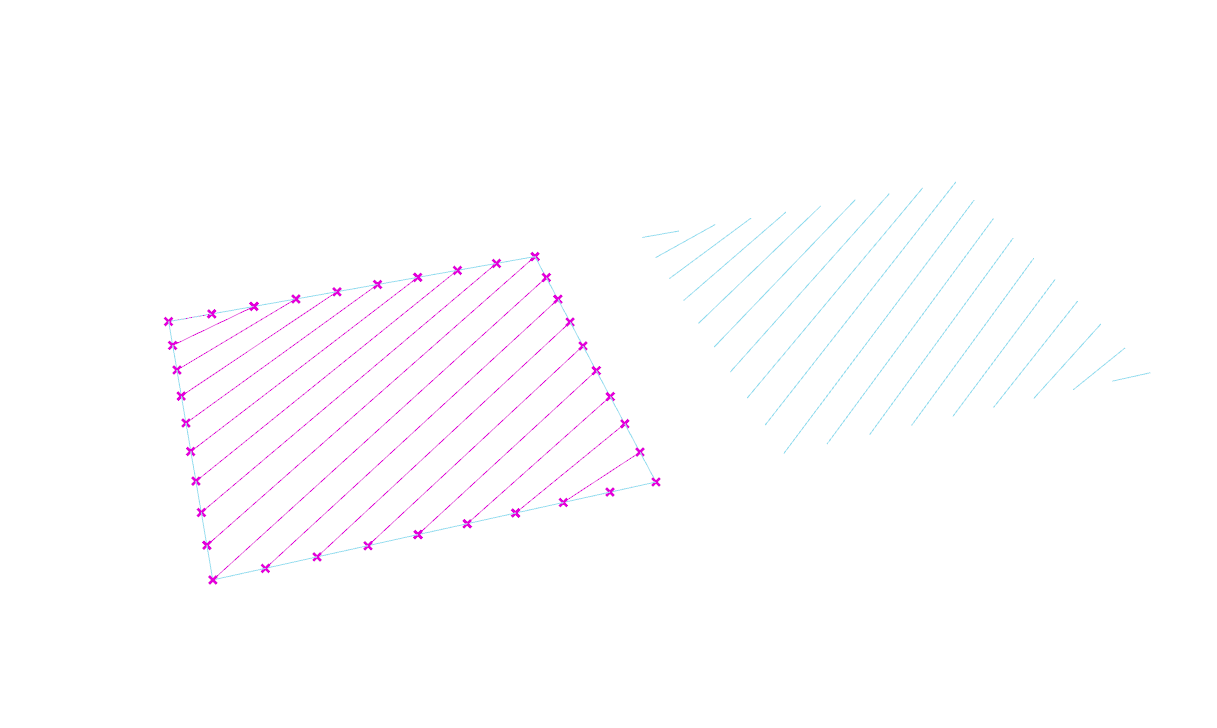
He’s an example of a grid where each set has their own set of anchors. While this does show the flexibility of a grid, I think it’s far more advantageous for them to share the same base points.
8.2 – Basic Gridshells
The same principle is then applied to a series of surfaces with varied types of curvature.
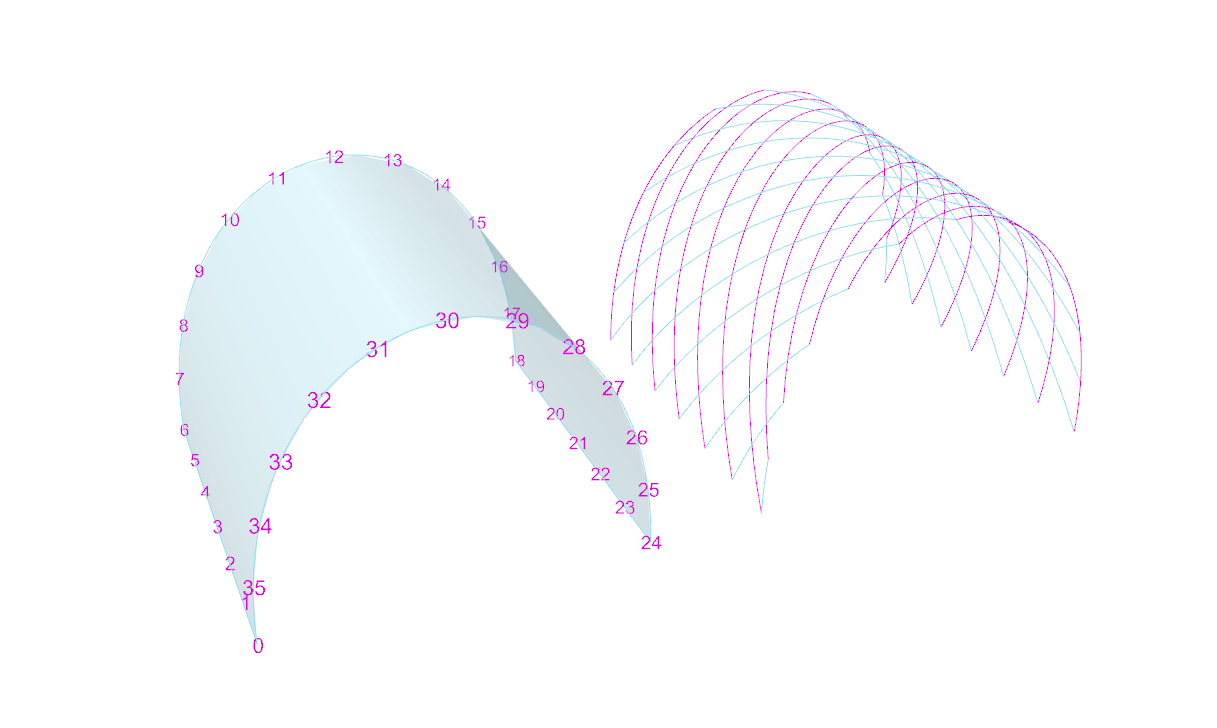
First comes the shell (a barrel vault in this case), then comes the grid. The symmetrical nature of this surface translates to a pretty regular (and also symmetrical) gridshell. The use of geodesic curves means that these gridshells can be fabricated using completely straight material, that only necessitate single curvature.
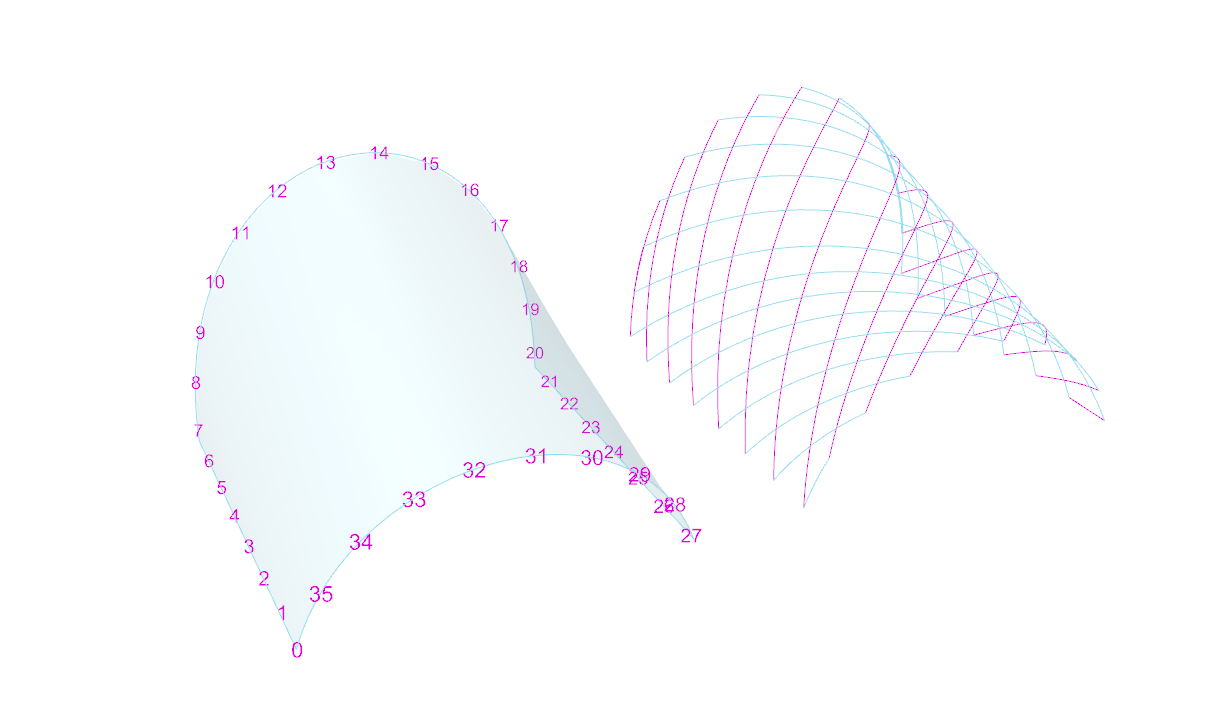
The same grid used on a conical surface starts to reveal gradual shifts in the geometry’s spacing. The curves always search for the path of least resistance in terms of bending.
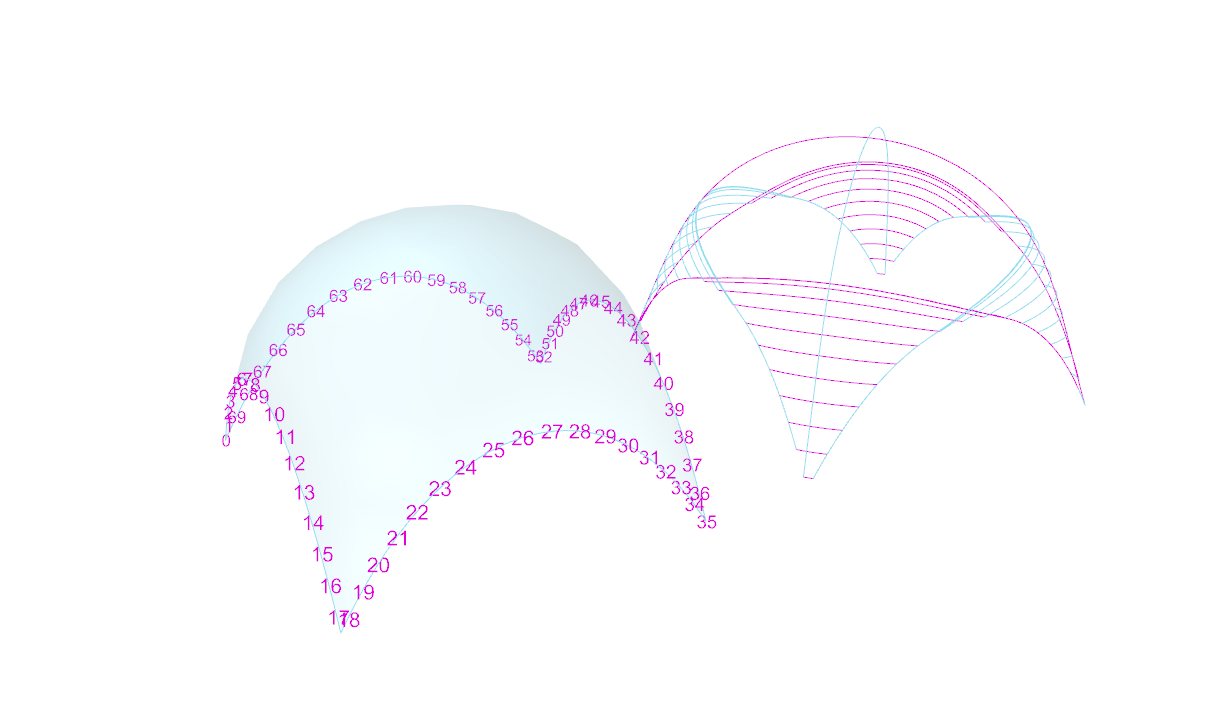
This case illustrates the nature of geodesic curves quite well. The dome was free-formed with a relatively high degree of curvature. A small change in the location of each anchor point translates to a large change in curvature between them. Each curve looks for the shortest path between each pair (without leaving the surface), but only has access to single curvature.
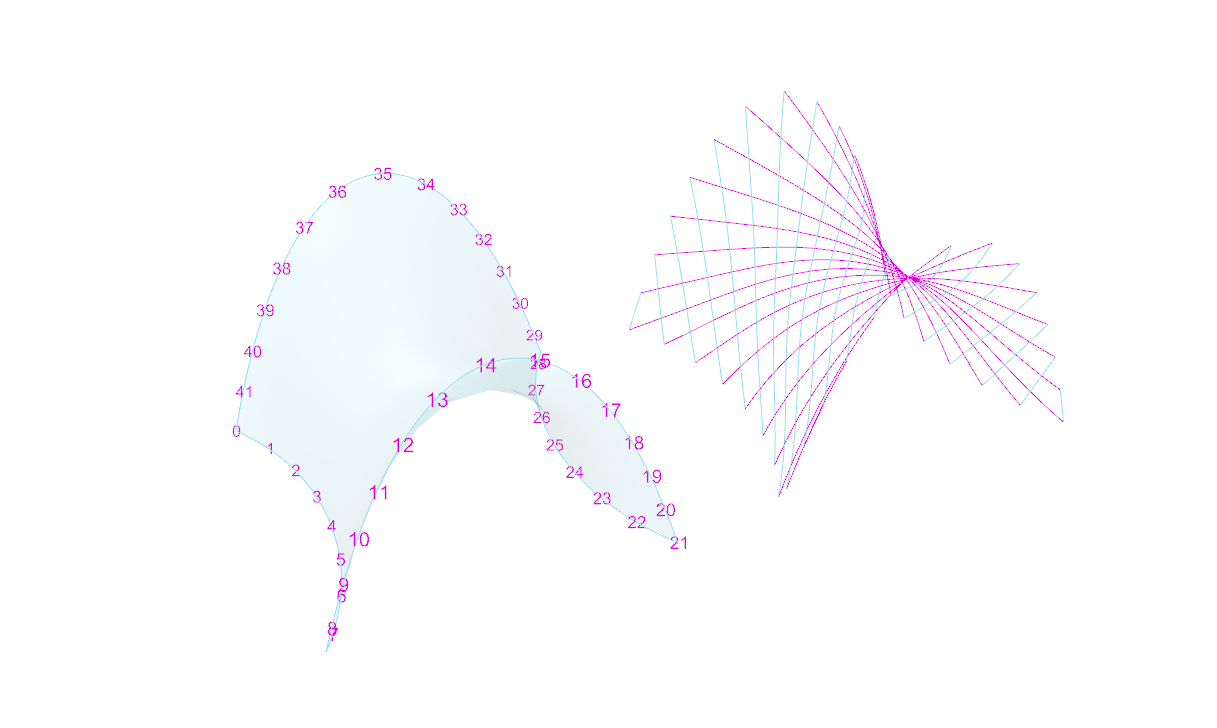
Structurally speaking, things get much more interesting with anticlastic curvature. As previously stated, each member will behave differently based on their relative curvature and orientation in relation to the surface. Depending on their location on a gridshell, plank lines can act partly in compression and partly in tension.
On another note:
While geodesic curves make it far more practical to fabricate shells, they are not a strict requirement. Using non-geodesic curves just means more time, money, and effort must go into the fabrication of each component. Furthermore, there’s no reason why you can’t use alternate grid patterns. In fact, you could use any pattern under the sun – any motif your heart desires (even tessellated puppies.)
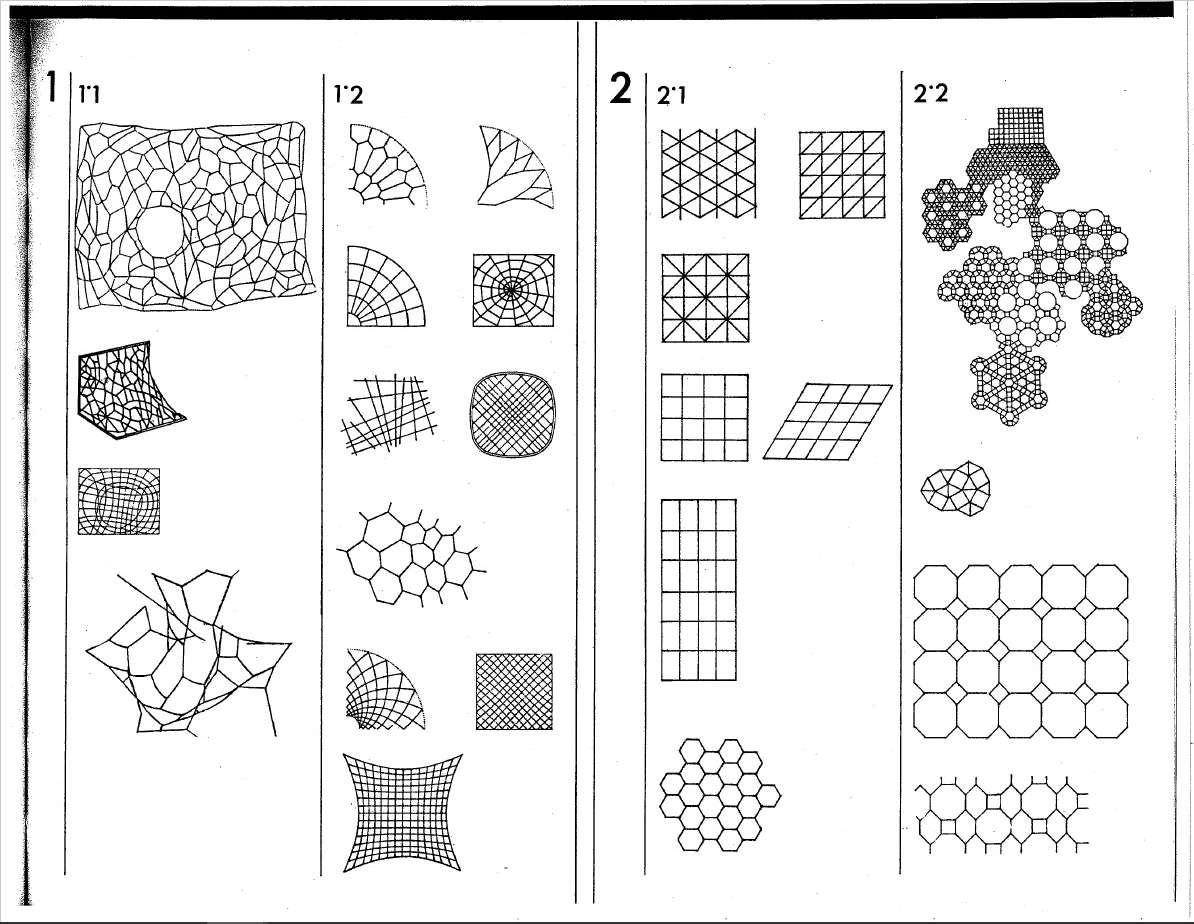
Here are just a few of the endless possible pattern. They all have their advantages and disadvantages in terms of fabrication, as well as structural potential.
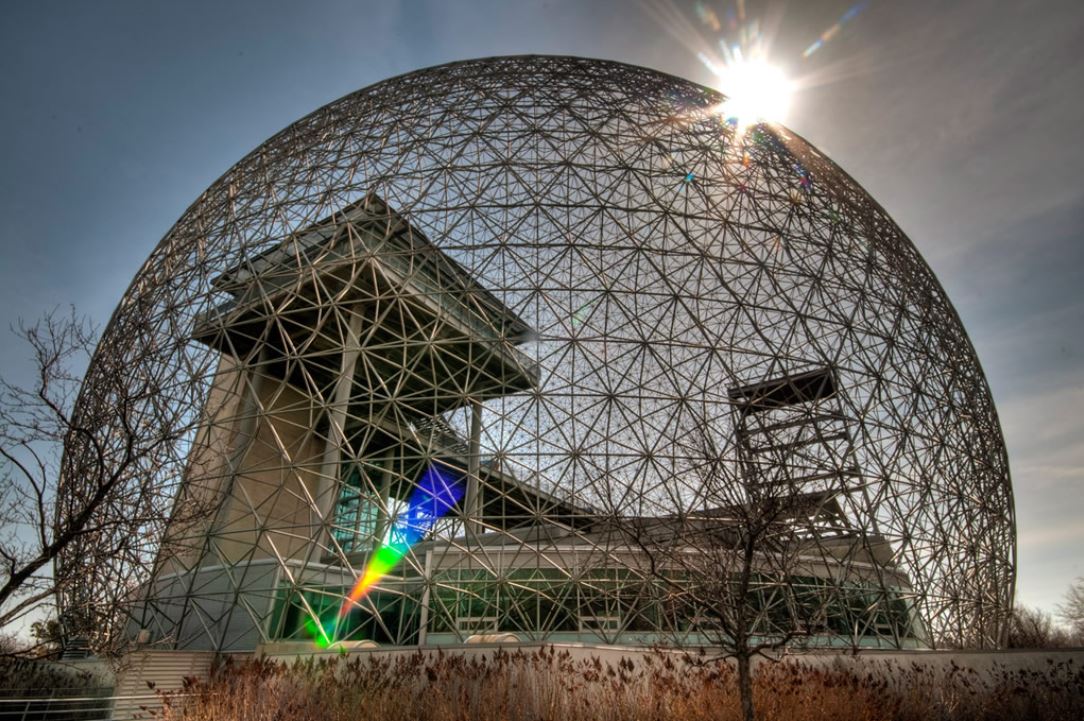
Gridshells with large amounts of triangulation, such as Buckminster Fuller’s geodesic spheres, typically perform incredibly well structurally. These structure are also highly efficient to manufacture, as their geometry is extremely repetitive.
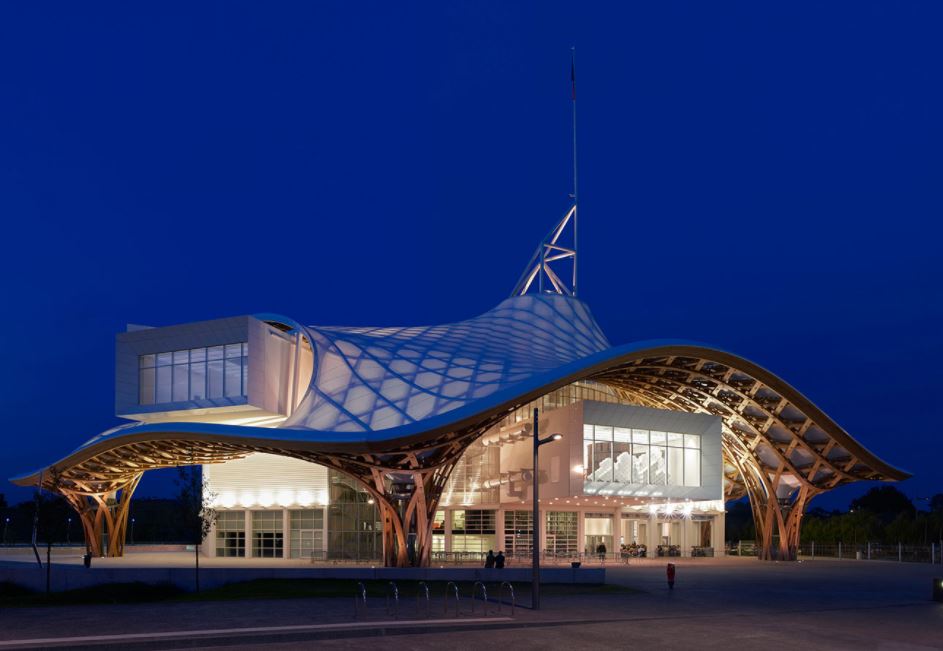
Gridshells with highly irregular geometry are far more challenging to fabricate. In this case, each and every piece had to be custom made to shape; I imagine it must have costed a lot of money, and been a logistical nightmare. Although it is an exceptionally stunning piece of architecture (and a magnificent feat of engineering.)
8.3 – Gridshell Construction
In our case, building these shells is simply a matter of converting the geodesic curves into planks lines.
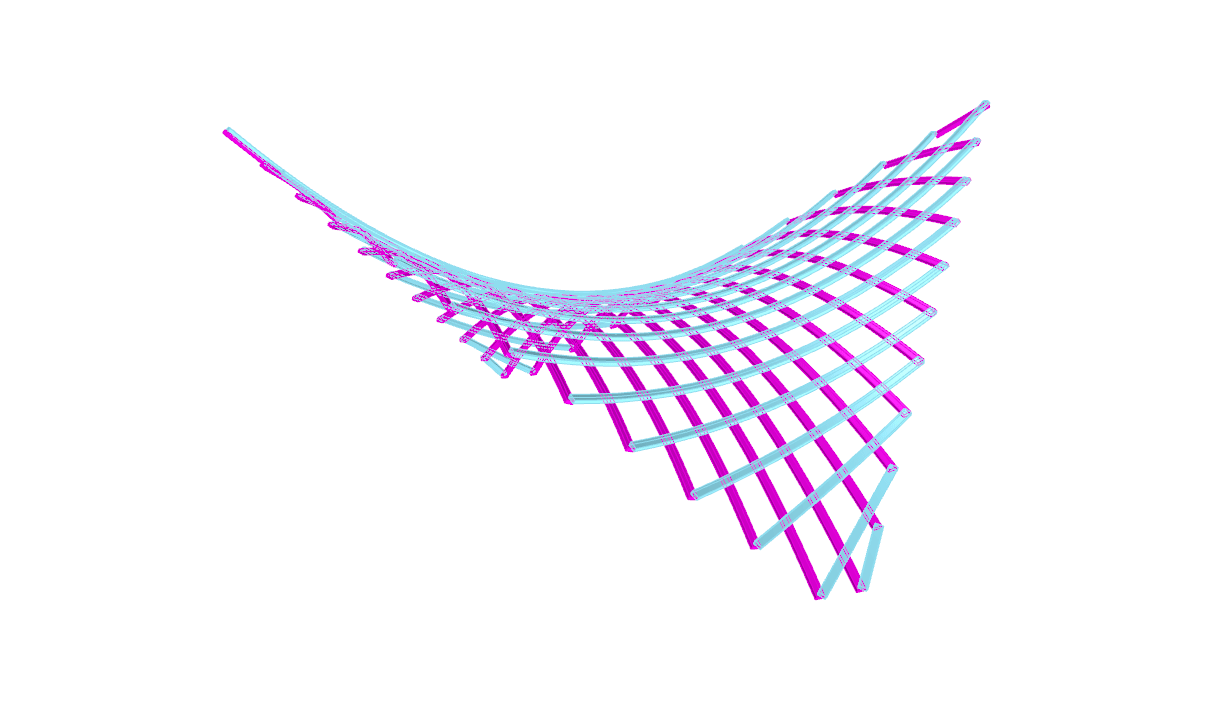
The whole point of using them in the first place is so that we can make them out of straight material that don’t necessitate double curvature. This example is rotating so the shape is easier to understand. It’s grid is also rotating to demonstrate the ease at which you can play with the geometry.
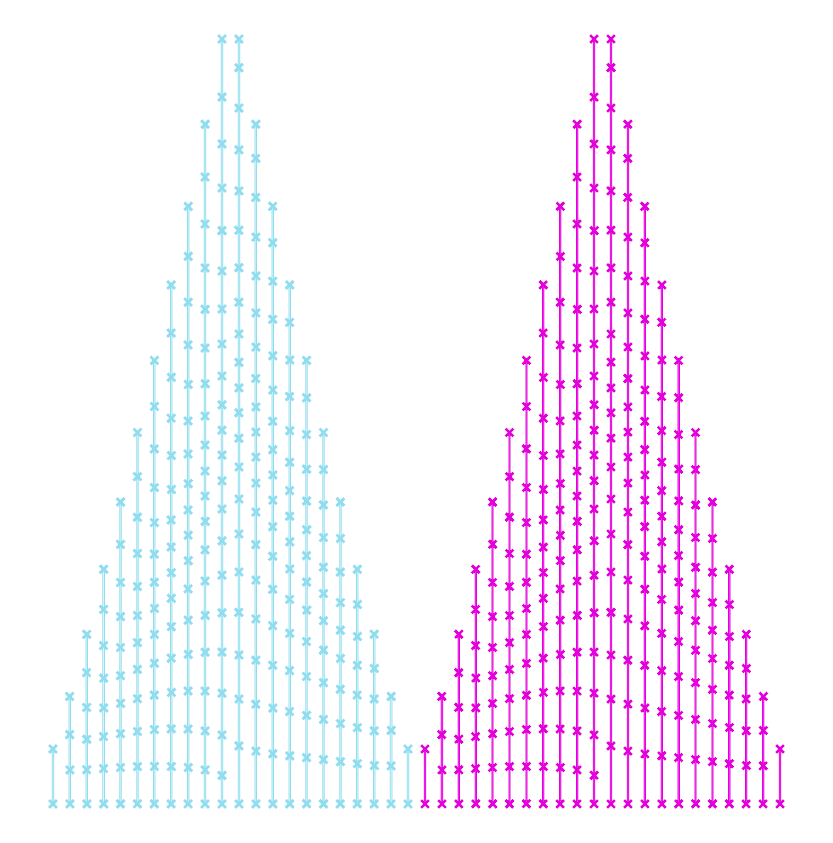
This is what you get by taking those plank lines and laying them flat. In this case both sets are the same because the shell happens to the identicall when flipped. Being able to use straight material means far less labour and waste, which translates to faster, and or cheaper, fabrication.
An especially crucial aspect of gridshells is the bracing. Without support in the form of tension ties, cable ties, ring beams, anchors etc., many of these shells can lay flat. This in and of itself is pretty interesting and does lends itself to unique construction challenges and opportunities. This isn’t always the case though, since sometimes it’s the geometry of the joints holding the shape together (like the geodesic spheres.) Sometimes the member are pre-bent (like Pompidou-Metz.) Although pre-bending the timber kinda strikes me as cheating thought.. As if it’s not a genuine, bona fide gridshell.
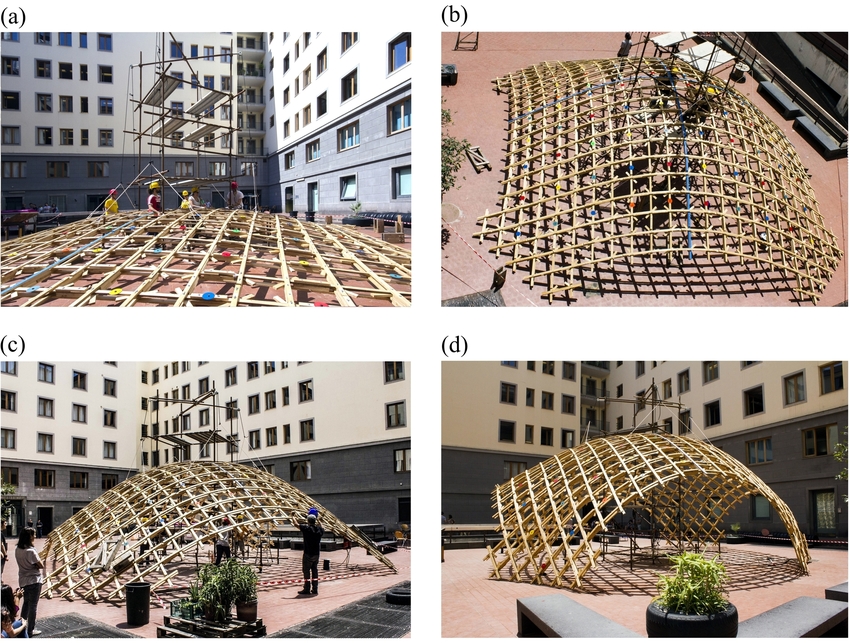
This is one of the original build method, where the gridshell is assembled flat, lifted into shape, then locked into place.
9.0 Form Finding
Having studied the basics makes exploring increasingly elaborate geometry more intuitive. In principal, most of the shells we’ve looked are known to perform well structurally, but there are strategies we can use to focus specifically on performance optimization.
9.0 – Minimal Surfaces
These are surfaces that are locally area-minimizing – surfaces that have the smallest possible area for a defined boundary. They necessarily have zero mean curvature, i.e. the sum of the principal curvatures at each point is zero. Soap bubbles are a great example of this phenomenon.
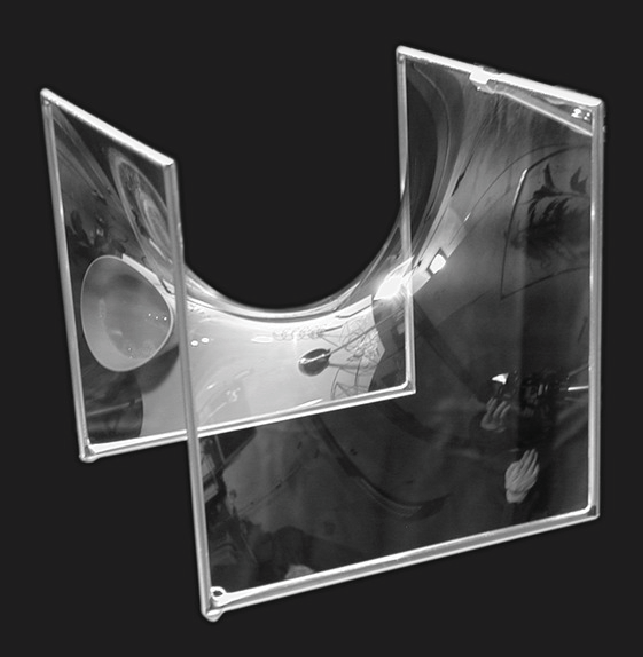
Hyperbolic Paraboloid Soap Bubble [Source: Serfio Musmeci’s “Froms With No Name” and “Anti-Polyhedrons”]Soap film inherently forms shapes with the least amount of area needed to occupy space – that minimize the amount of material needed to create an enclosure. Surface tension has physical properties that naturally relax the surface’s curvature.
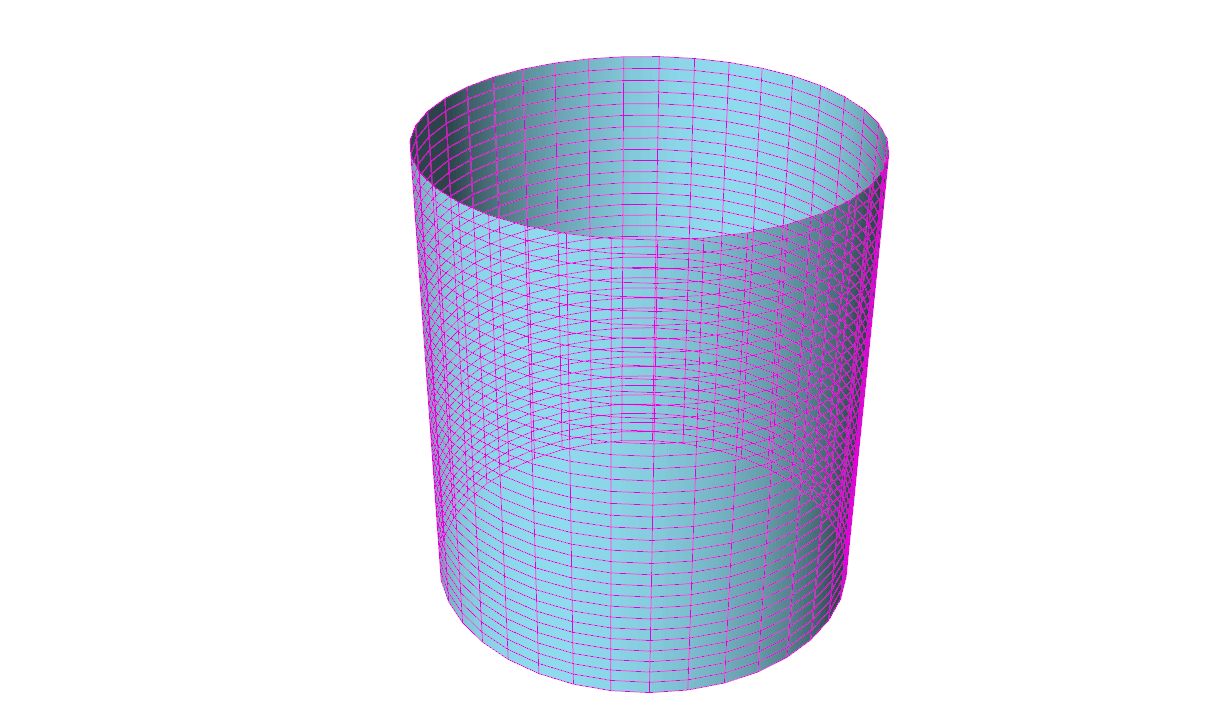
We can simulate surface tension by using a network of curves derived from a given shape. Applying varies material properties to the mesh results in a shape that can behaves like stretchy fabric or soap. Reducing the rest length of each of these curves (while keeping the edges anchored) makes them pull on all of their neighbours, resulting in a locally minimal surface.
Here are a few more examples of minimal surfaces you can generate using different frames (although I’d like stress that the possibilities are extremely infinite.) The first and last iterations may or may not count, depending on which of the many definitions of minimal surfaces you use, since they deal with pressure. You can read about it in much greater detail here: https://tinyurl.com/ya4jfqb2

Here we have one of the most popular examples of minimal surface geometry in architecture. The shapes of these domes were derived from a series of studies using clustered soap bubbles. The result is a series of enormous shells built with an impressively small amount of material.
Triply periodic minimal surfaces are also a pretty cool thing (surfaces that have a crystalline structure – that tessellate in three dimensions):
9.2 – Catenary Structures
Another powerful method of form finding has been to let gravity dictate the shapes of structures. In physics and geometry, catenary (derived from the Latin word for chain) curves are found by letting a chain, rope or cable, that has been anchored at both end, hang under its own weight. They look similar to parabolic curves, but perform differently.
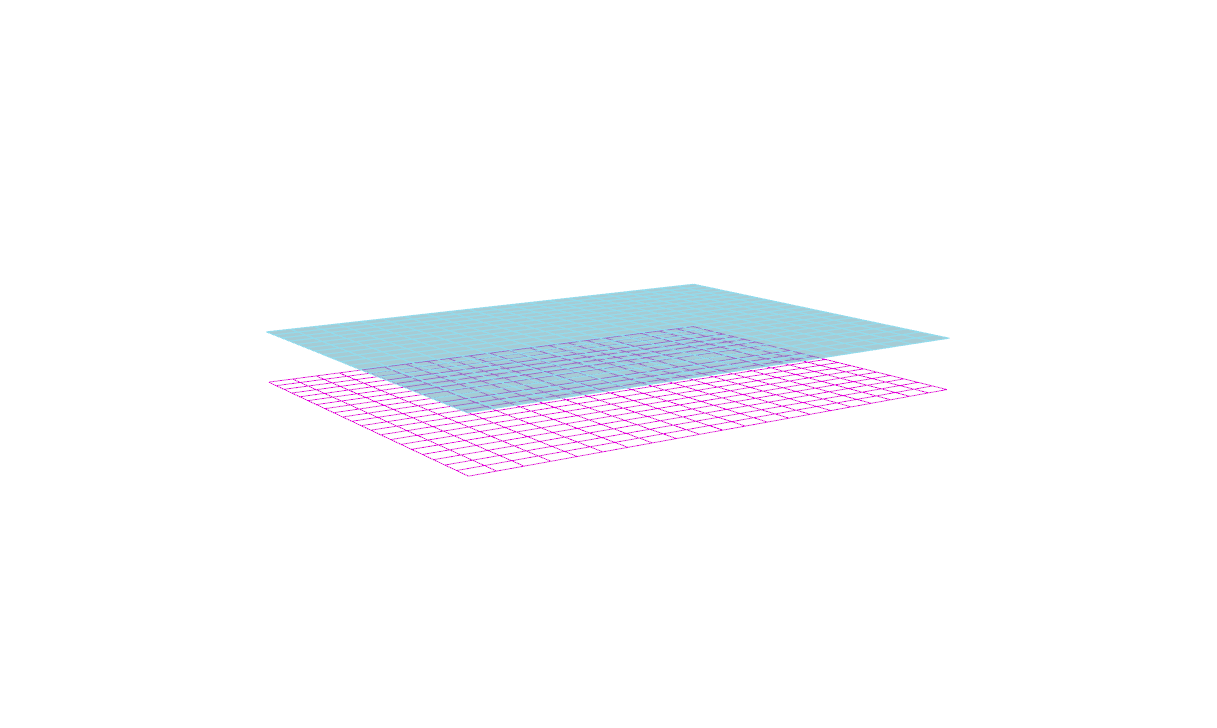
A net shown here in magenta has been anchored by the corners, then draped under simulated gravity. This creates a network of hanging curves that, when converted into a surface, and mirrored, ultimately forms a catenary shell. This geometry can be used to generate a gridshell that performs exceptionally well under compression, as long as the edges are reinforced and the corners are braced.
While I would be remiss to not mention Antoni Gaudí on the subject of catenary structure, his work doesn’t particularly fall under the category of gridshells. Instead I will proceed to gawk over some of the stunning work by Frei Otto.
Of course his work explored a great deal more than just catenary structures, but he is revered for his beautiful work on gridshells. He, along with the Institute for Lightweight Structures, have truly been pioneers on the front of theoretical structural engineering.
9.3 – Biomimicry in Architecture
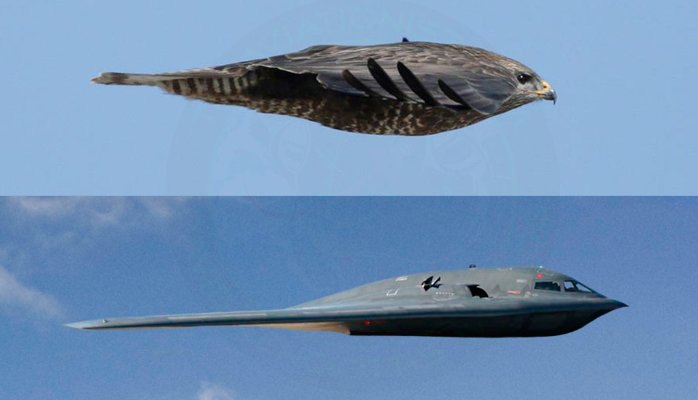
Frei Otto is a fine example of ecological literacy at its finest. A profound curiosity of the natural world greatly informed his understanding of structural technology. This was all nourished by countless inquisitive and playful investigations into the realm of physics and biology. He even wrote a series of books on the way that the morphology of bird skulls and spiderwebs could be applied to architecture called Biology and Building. His ‘IL‘ series also highlights a deep admiration of the natural world.
Of course he’s the not the only architect renown their fascination of the universe and its secrets; Buckminster Fuller and Antoni Gaudí were also strong proponents of biomimicry, although they probably didn’t use the term (nor is the term important.)
Gaudí’s studies of nature translated into his use of ruled geometrical forms such as hyperbolic paraboloids, hyperboloids, helicoids etc. He suggested that there is no better structure than the trunk of a tree, or a human skeleton. Forms in biology tend to be both exceedingly practical and exceptionally beautiful, and Gaudí spent much of his life discovering how to adapt the language of nature to the structural forms of architecture.
Fractals were also an undisputed recurring theme in his work. This is especially apparent in his most renown piece of work, the Sagrada Familia. The varying complexity of geometry, as well as the particular richness of detail, at different scales is a property uniquely shared with fractal nature.
Antoni Gaudí and his legacy are unquestionably one of a kind, but I don’t think this is a coincidence. I believe the reality is that it is exceptionally difficult to peruse biomimicry, and especially fractal geometry, in a meaningful way in relation to architecture. For this reason there is an abundance of superficial appropriation of organic, and mathematical, structures without a fundamental understanding of their function. At its very worst, an architect’s approach comes down to: ‘I’ll say I got the structure from an animal. Everyone will buy one because of the romance of it.”
That being said, modern day engineers and architects continue to push this envelope, granted with varying levels of success. Although I believe that there is a certain level of inevitability when it comes to how architecture is influenced by natural forms. It has been said that, the more efficient structures and systems become, the more they resemble ones found in nature.
Euclid, the father of geometry, believed that nature itself was the physical manifestation of mathematical law. While this may seems like quite a striking statement, what is significant about it is the relationship between mathematics and the natural world. I like to think that this statement speaks less about the nature of the world and more about the nature of mathematics – that math is our way of expressing how the universe operates, or at least our attempt to do so. After all, Carl Sagan famously suggested that, in the event of extra terrestrial contact, we might use various universal principles and facts of mathematics and science to communicate.
Developing Space-Filling Fractals
Delving deeper into the world of mathematics, fractals, geometry, and space-filling curves.
Foreword
4.0 Classic Space-Filling
4.1 Early Examples
In 1890, Giuseppe Peano discovered the first of what would be called space-filing curves:

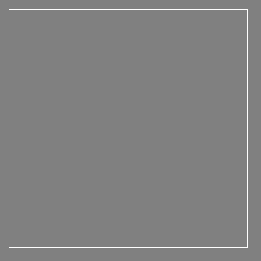
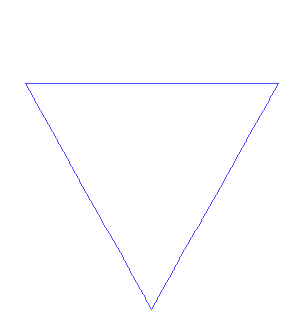

4.2 Later Examples
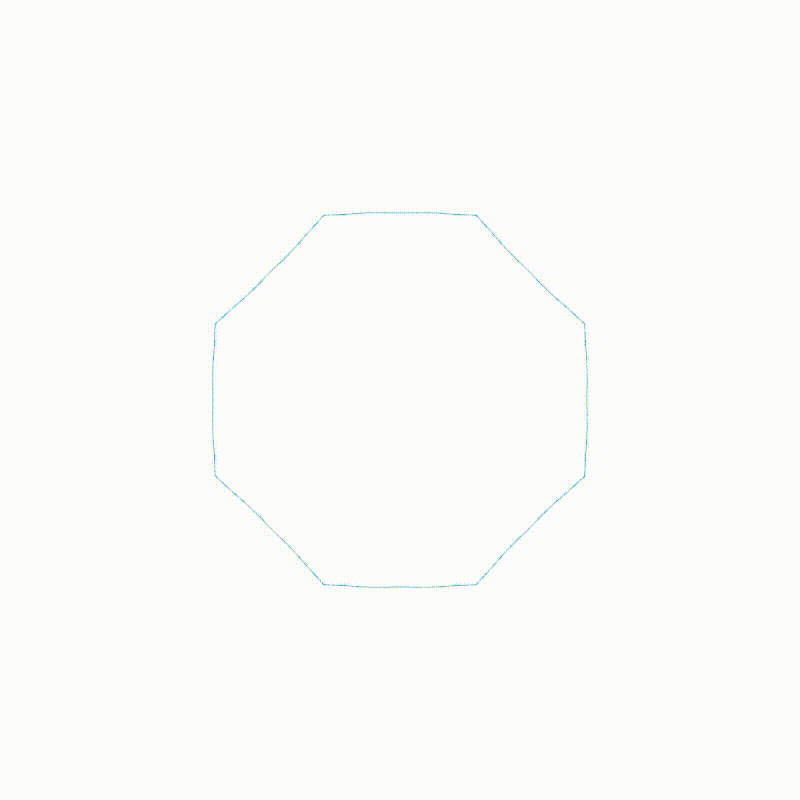
On A Strange Note:

5.0 Avant-Garde Space-Filling
5.1 The Traveling Salesman Problem
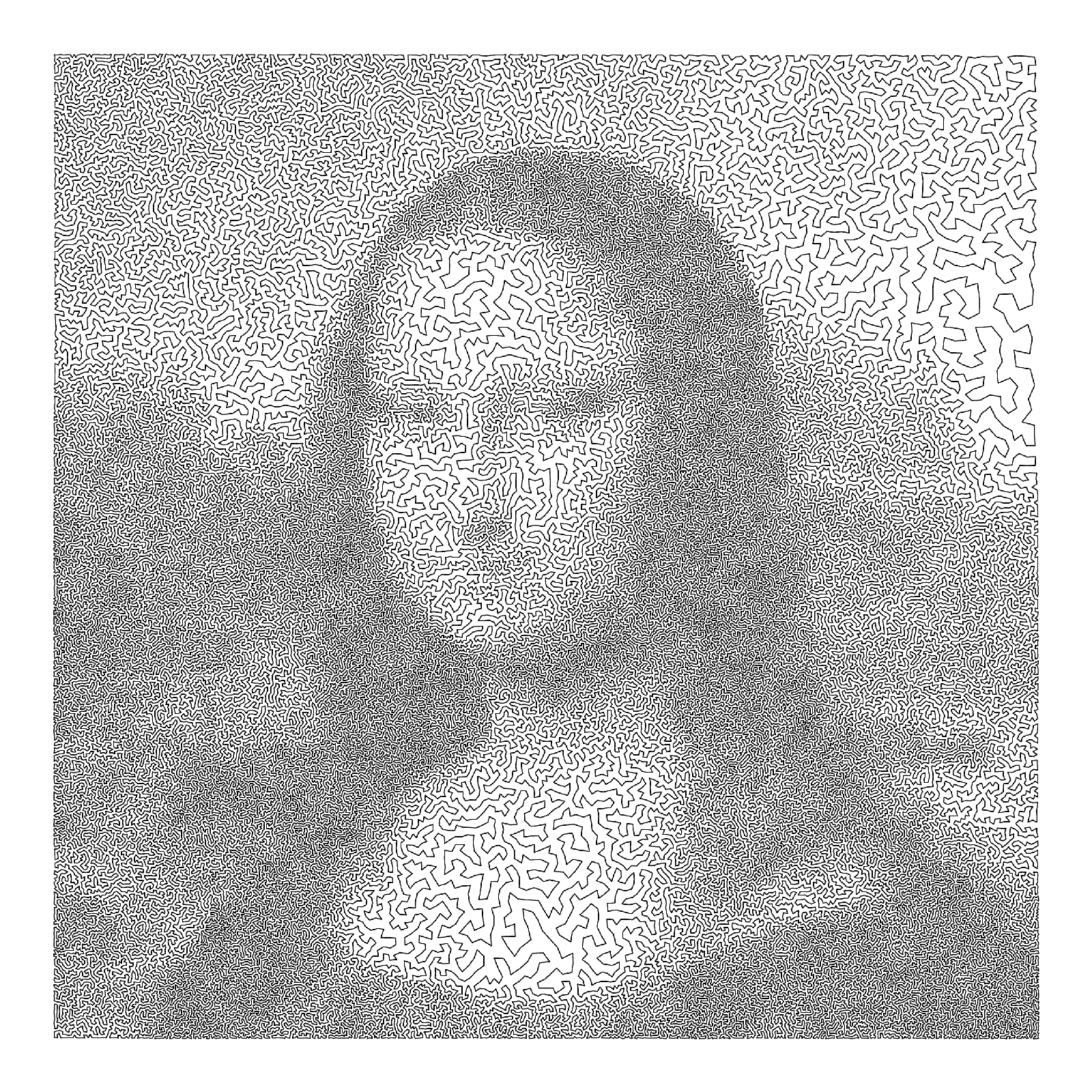
5.2 Differential Growth
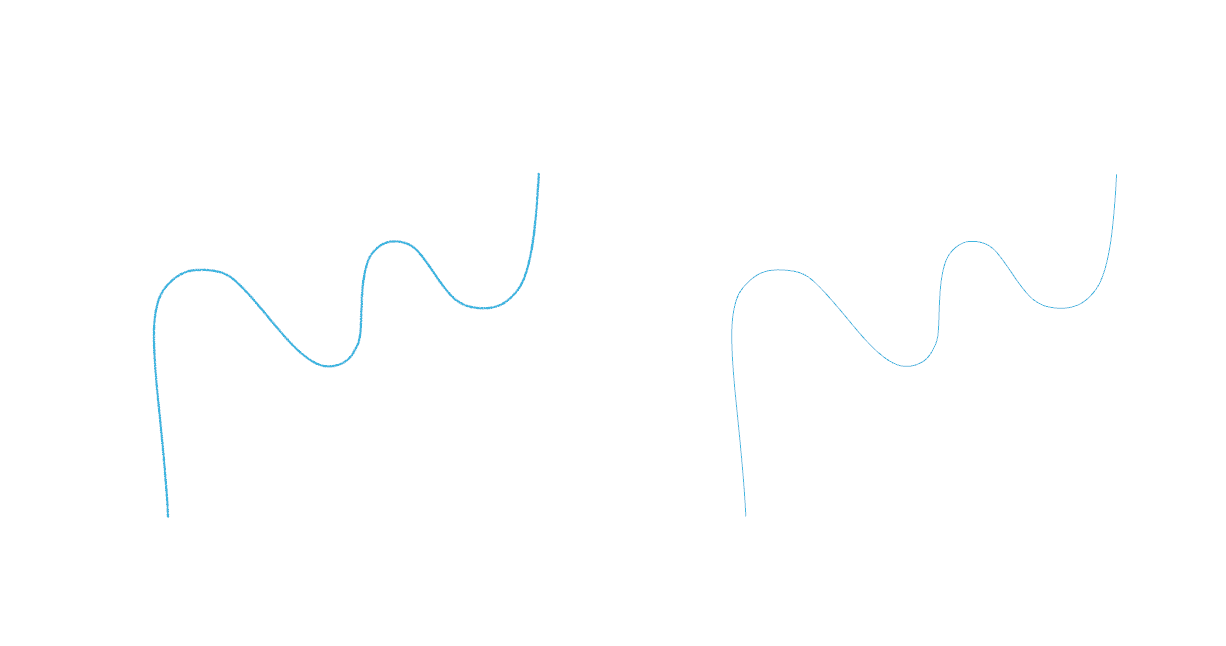
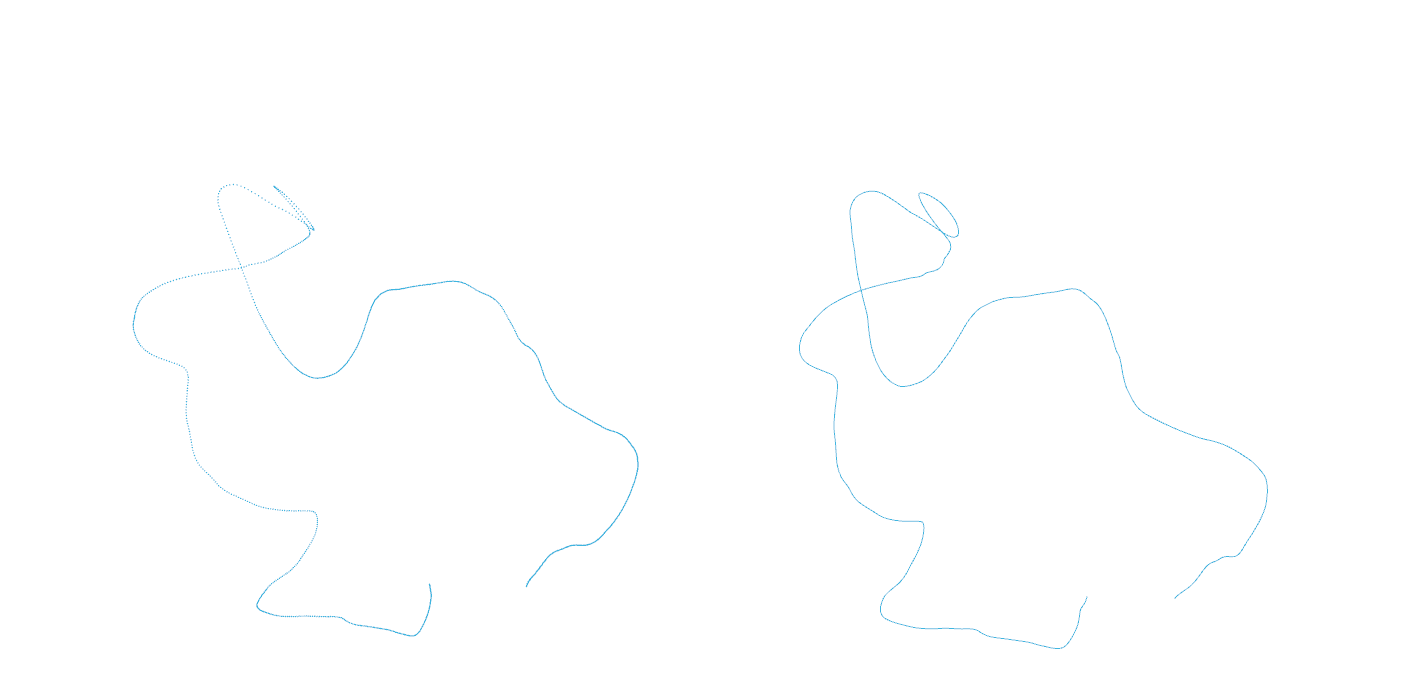
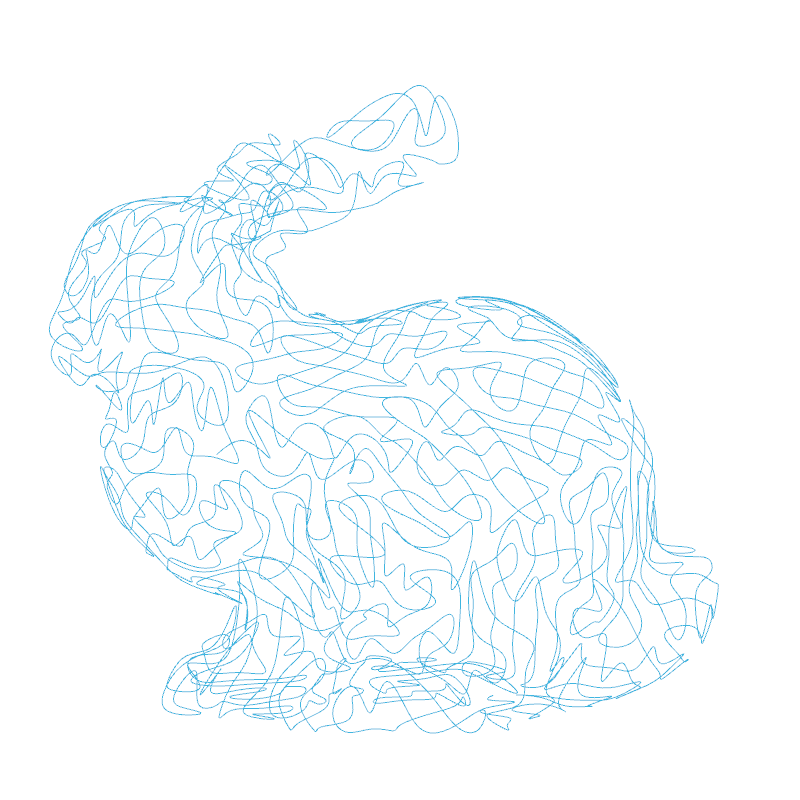


6.0 Developing Fractal Curves
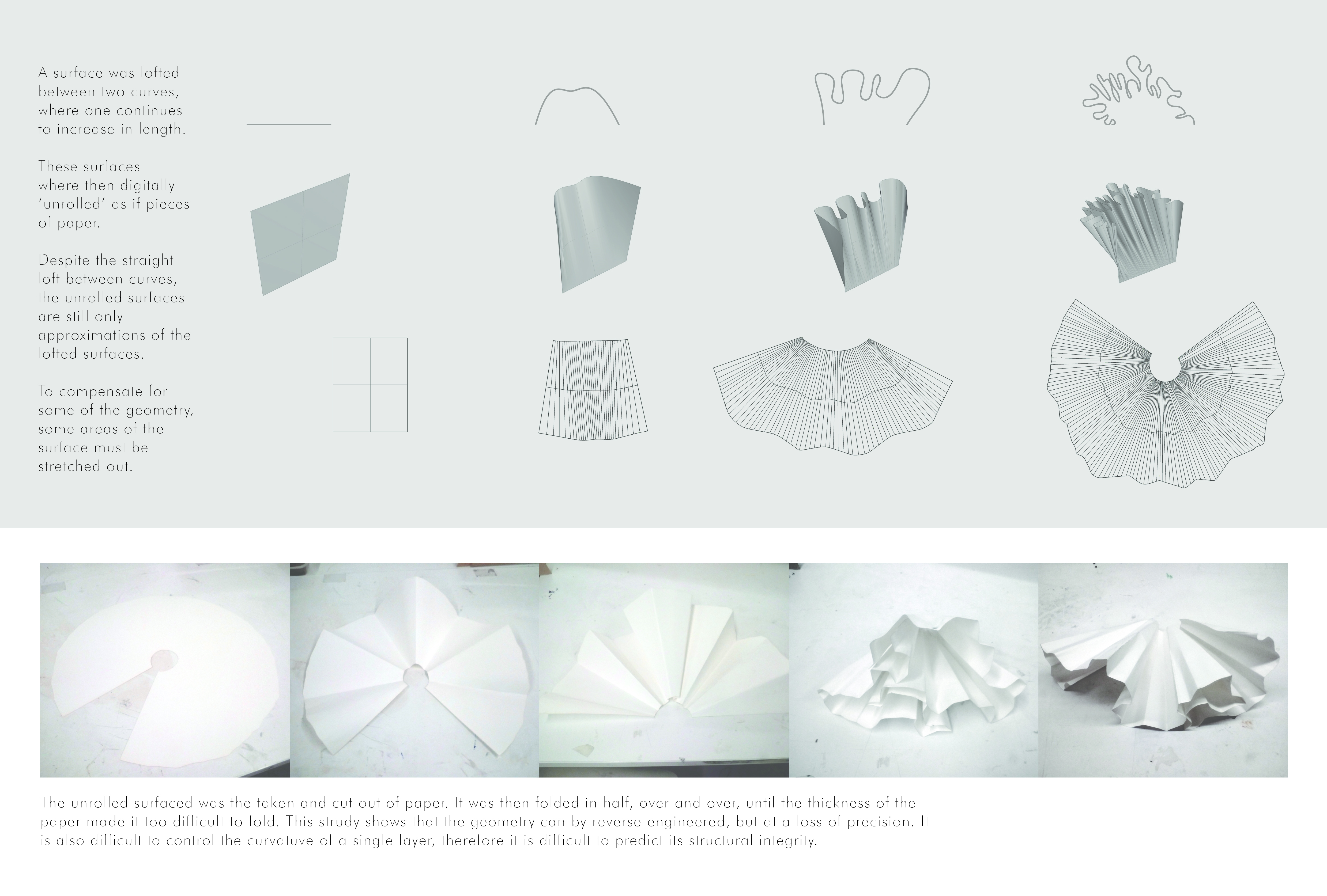
6.1 Dragon’s Feet
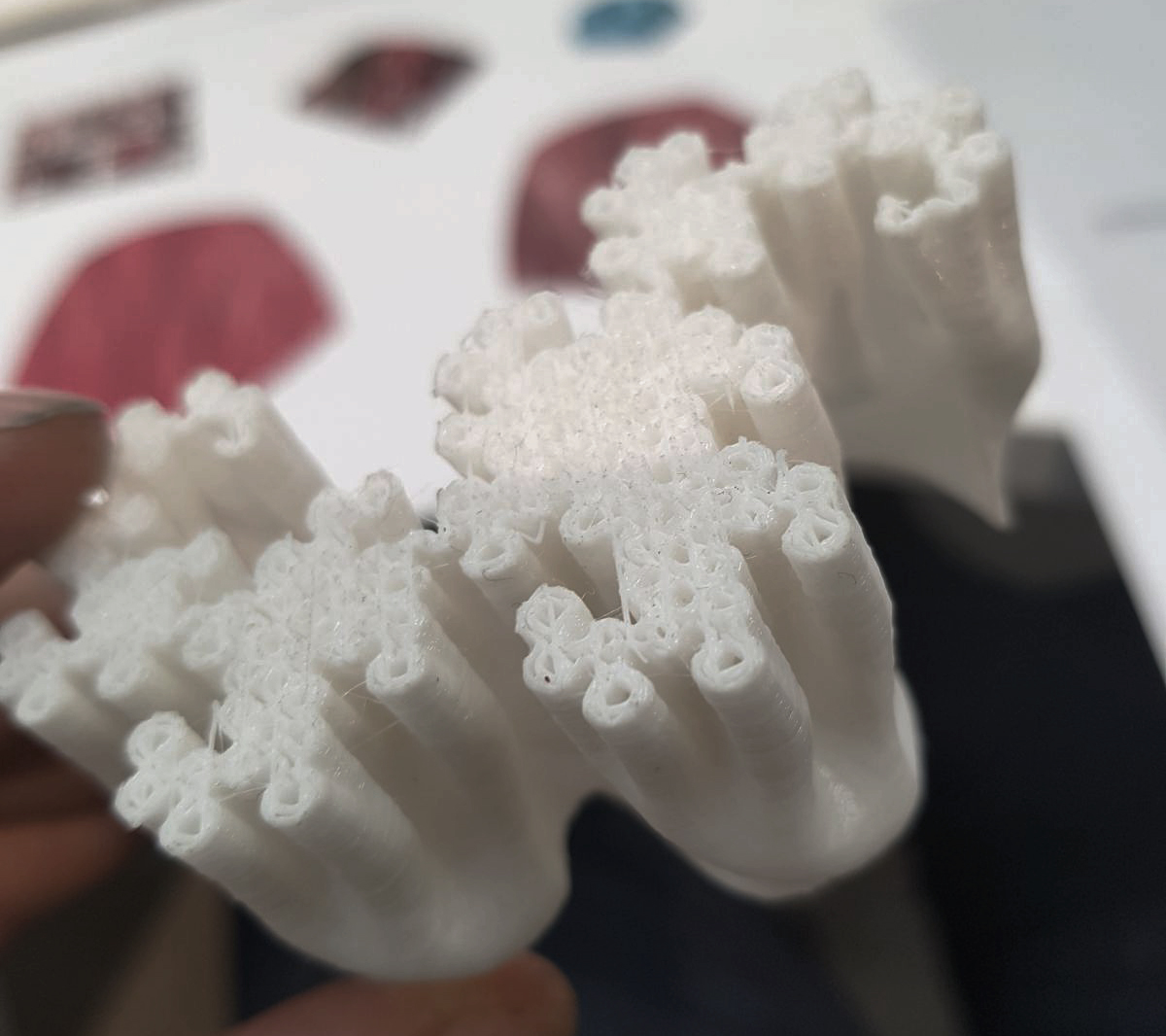
6.2 Hilbert’s Curtain
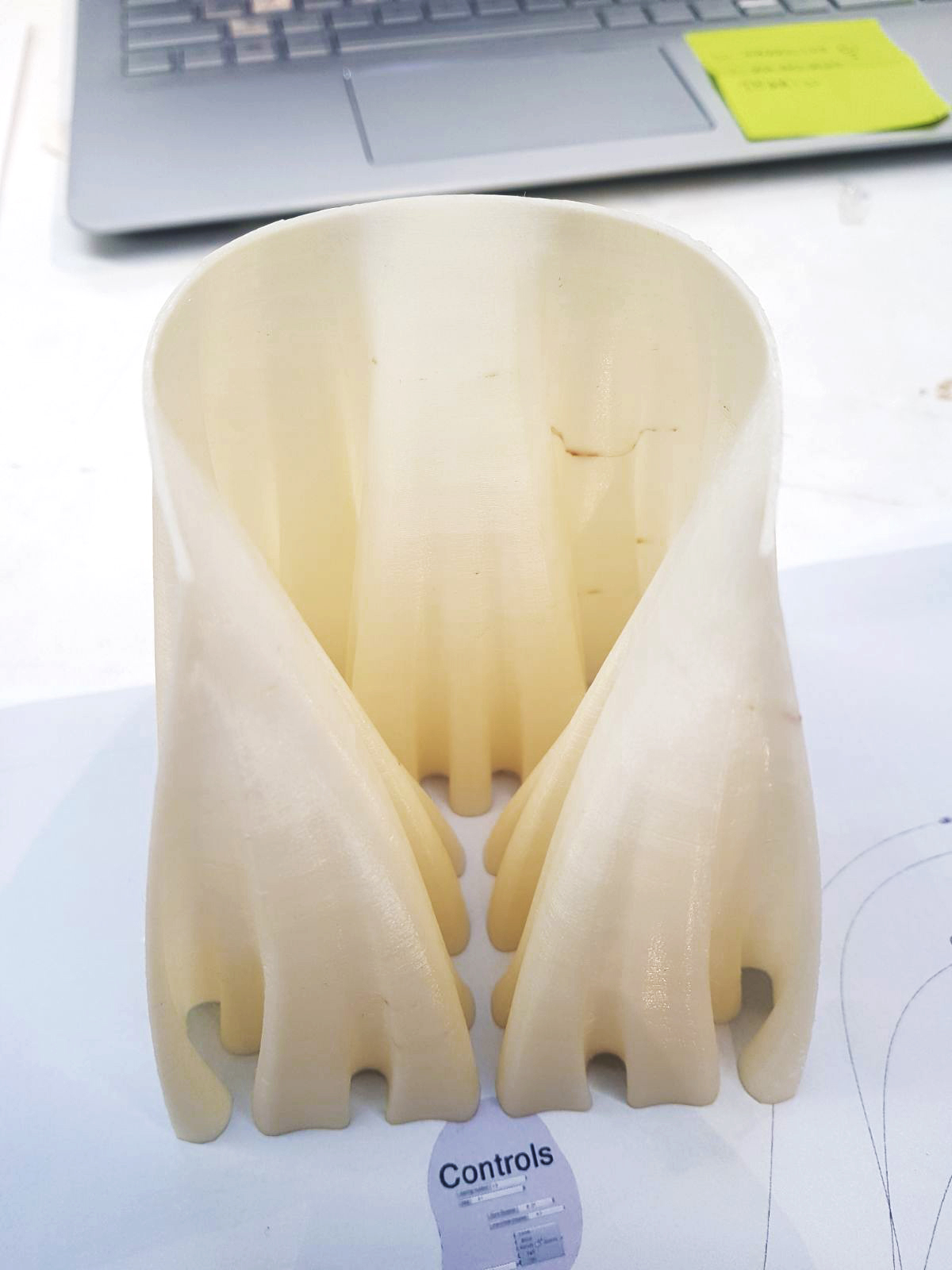
6.3 Developing Whale Curve
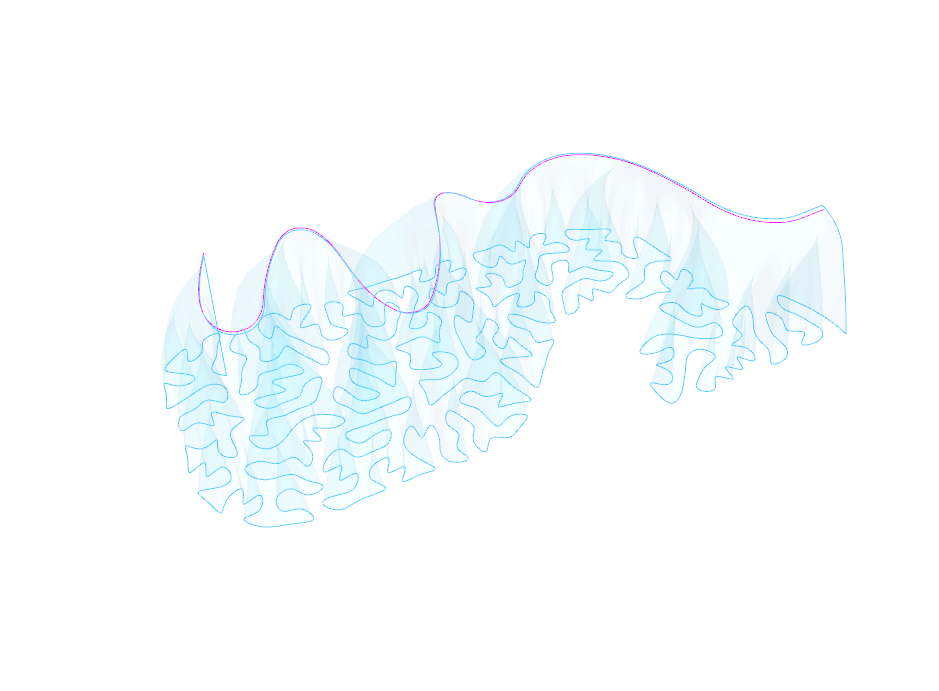
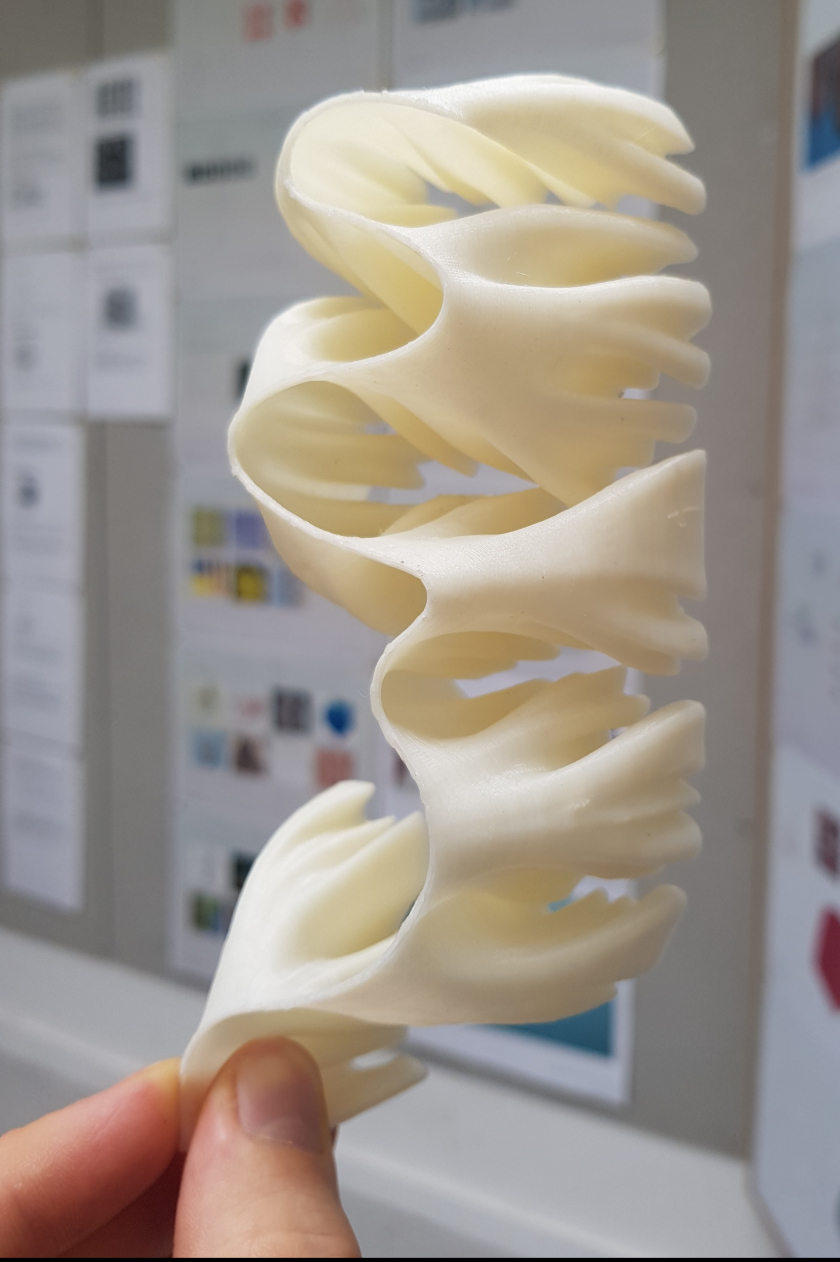
Omnis Stellae
Omnis Stellae – Redrawing your own constellation
“Only in the darkness can you see the stars”
Martin Luther King
This project involves the conception and design of a new way of mapping constellations, based on subdivision processes like Stellation. It explores how subdivision can define and embellish architectural design with an elaborate system of fractals based on mathematics and complex algorithms.

An abstracted form of galaxy is used as an input form to the subdivision process called Stellation. In geometry, meaning the process of extending a polytope in n dimensions to form a new figure. Starting with an original figure, the process extends specific elements such as its edges or face planes, usually in a symmetrical way, until they meet each other again to form the closed boundary of a new figure.

The material used for this installation will be timber sheets of 1/3 of an inch thickness that will be laser-cut.The panels will be connected to each other with standard connection elements which have already been tested structurally based on an origami structure.
The lighting of the installation will consist on LED strips that will light with burners interactions.

Although stars in constellations appear near each other in the sky, they usually lie at a variety of distances away from the observer. Since stars also travel along their own orbits through the Milky Way, the constellation outlines change slowly over time and through perspective.
There are 88 constellations set at the moment, but I would like to prove that there are infinite amount of stars that have infinite amount of connections with each other.The installation will show you all the possible connections between this stars, but will never rule which connection is the one you need to make.

I would like burners to choose their own stars and draw their own constellations. Any constellation that they can possibly imagine from their one and only perspective, using coloured lights that react to their touch.
The end result will have thousands of different geometries/constellations that will have a meaning for each one of the burners and together will create a new meaningful lighted galaxy full of stars.

On a clear night, away from artificial light, it’s possible to see over 5000 stars with the naked eye. These appear to orbit the Earth in a fixed pattern, as if they are attached to a giant sphere that makes one revolution a day.This stars though are organised in Constellations.
The word “constellation” seems to come from the Late Latin term cōnstellātiō, which can be translated as “set of stars”. The relationship between this sets of stars has been drawn by the perspective of the human eye.

“Omnis Stellae” is a manifestation of the existence of different perspectives. For me, there is great value in recognising different perspectives in life, because nothing is really Black and White, everything relates to the point of view and whose point of view and background that is.
As a fractal geometry this installation embodies an endless number of stars that each person can connect and imagine endless geometries, that will only make sense from their own perspective. The stellated geometry will show you all the possible connections but will never impose any.

“Omnis Stellae” is about creating your own constellations and sharing them with the rest of the burners, is about sharing your own perspective of the galaxy and create some meaningful geometries that might not mean anything to other people but would mean the world to you.

The grand finale is if it could become the physical illustration of all the perspectives of the participants at Burning Man 2018 shown as one.
With Love,
Maya
The Wishing Well
something caught in between dimensions – on its way to becoming more.
Summary
The Wishing Well is the physical manifestation, a snap-shot, of a creature caught in between dimensions – frozen in time. It is a digital entity that has been extracted from its home in the fractured planes of the mathematical realm; a differentially grown curve in bloom, organically filling space in the material world.
The notion of geometry in between dimensions is explored in a previous post: Shapes, Fractals, Time & the Dimensions they Belong to
Description
The piece will be built from the bottom-up. Starting with the profile of a differentially grown curve (a squiggly line), an initial layer will be set in pieces of 2 x 4 inch wooden studs (38 x 89 millimeter profile) laid flat, and anchored to the ground. Each subsequent layer will be built upon and fixed to the last, where each new layer is a slightly smoother version than the last. 210 layers will be used to reach a height of 26 feet (8 meters). The horizontal spaces in between each of the pieces will automatically generate hand and foot holes, making the structure easily climbable. The footprint of the build will be bound to a space 32 x 32 feet.
The design may utilize two layers, inner and out, that meet at the top to increase the structural integrity for the whole build. It will be lit from within, either from the ground with spotlights or with LED strip lights following patterns along the walls.

Ambition
At the Wishing Well, visitors embark on a small journey, exploring the uniquely complex geometry of the structure before them. As they approach the foot of the well, it will stand towering above them, undulating organically across the landscape. The nature of the structure’s curves beckons visitors to explore the piece’s every nook and cranny. Moreover, its stature grants a certain degree of shelter to any traveller seeking refuge from the Playa’s extreme weather conditions. The well’s shape and scale allows natural, and artificial, light to interact in curious ways with the structure throughout the day and night. The horizontal gaps between every ‘brick’ in the wall allows light to filter through each layer, which in turn casts intriguing shadows across the desert. This perforation also allows Burners to easily, and relatively safely, scale the face of the build. Visitors will have the opportunity to grant a wish by writing it down on a tag and fixing it to the well’s interior.
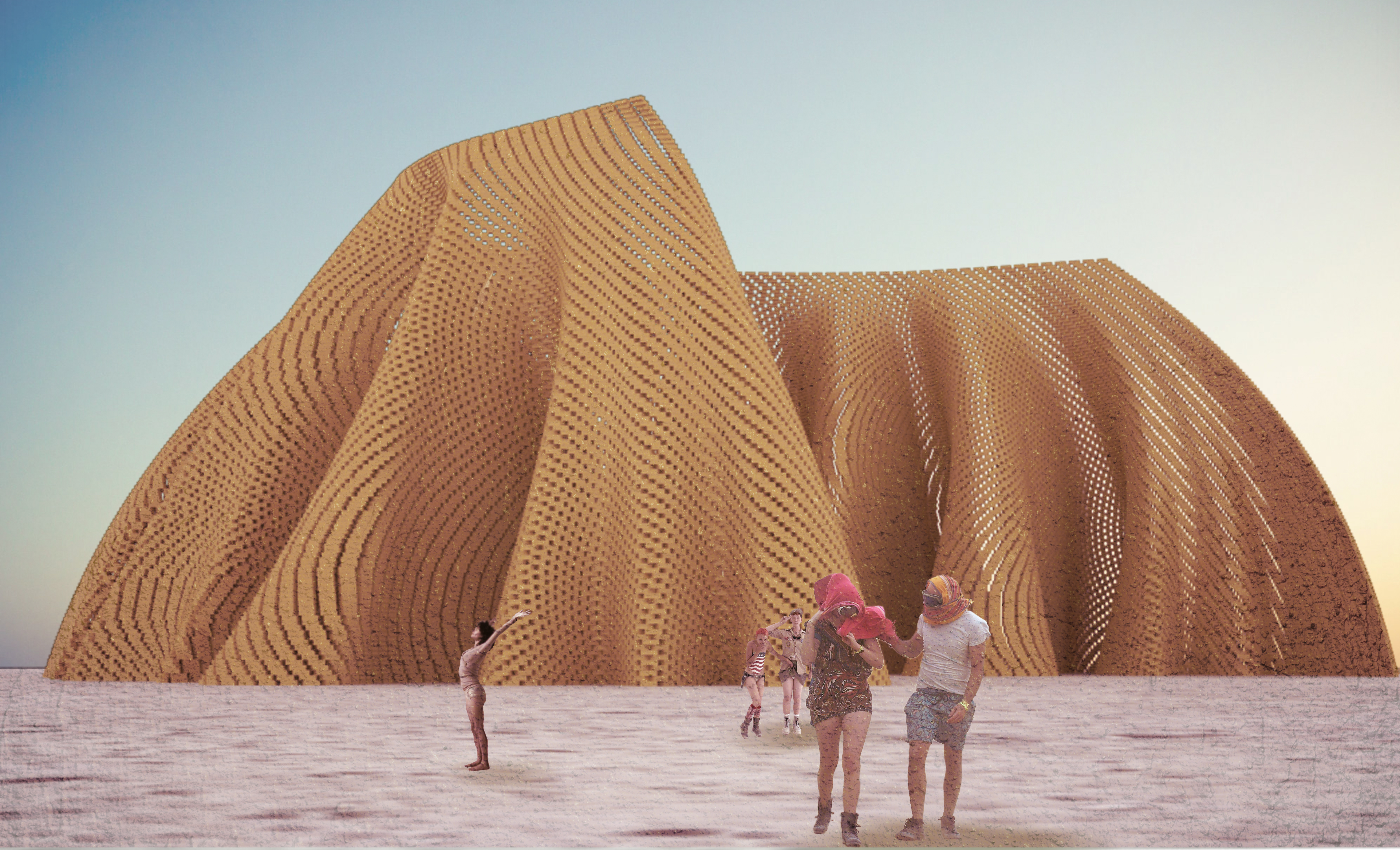
Philosophy
If you had one magical (paradox free) wish, to do anything you like, what would it be?
Anything can be wished for at the Wishing Well, but a wish will not come true if it is deemed too greedy. Visitors must write their wish down on a tag and fix it to the inside of the well. They must choose wisely, as they are only allowed one. Additionally, they may choose to leave a single, precious, offering. However, if the offering does not burn, it will not be accepted. Visitors will also find that they must tread lightly on other people’s wishes and offerings.
The color of the tag and offering are important as they are associated with different meanings:
- ► PINK – love
- ► RED – happiness, joy, success, good luck, passion, vitality, celebration
- ► ORANGE – change, adaptability, spontaneity, concentration
- ► YELLOW – nourishment, warmth, clarity, empathy, being free from worldly cares
- ► GREEN – growth, balance, healing, self-assurance, benevolence, patience
- ► BLUE – conservation, healing, relaxation, exploration, trust, calmness
- ► PURPLE – spiritual awareness, physical and mental healing
- ► BLACK – profoundness, stability, knowledge, trust, adaptability, spontaneity,
- ► WHITE – mourning, righteousness, purity, confidence, intuition, spirits, courage
The Wishing Well is a physical manifestation of the wishes it holds. They are something caught in between – on their way to becoming more. I wish for guests to reflect on where they’ve been, where they are, where they are going, and where they wish to go.
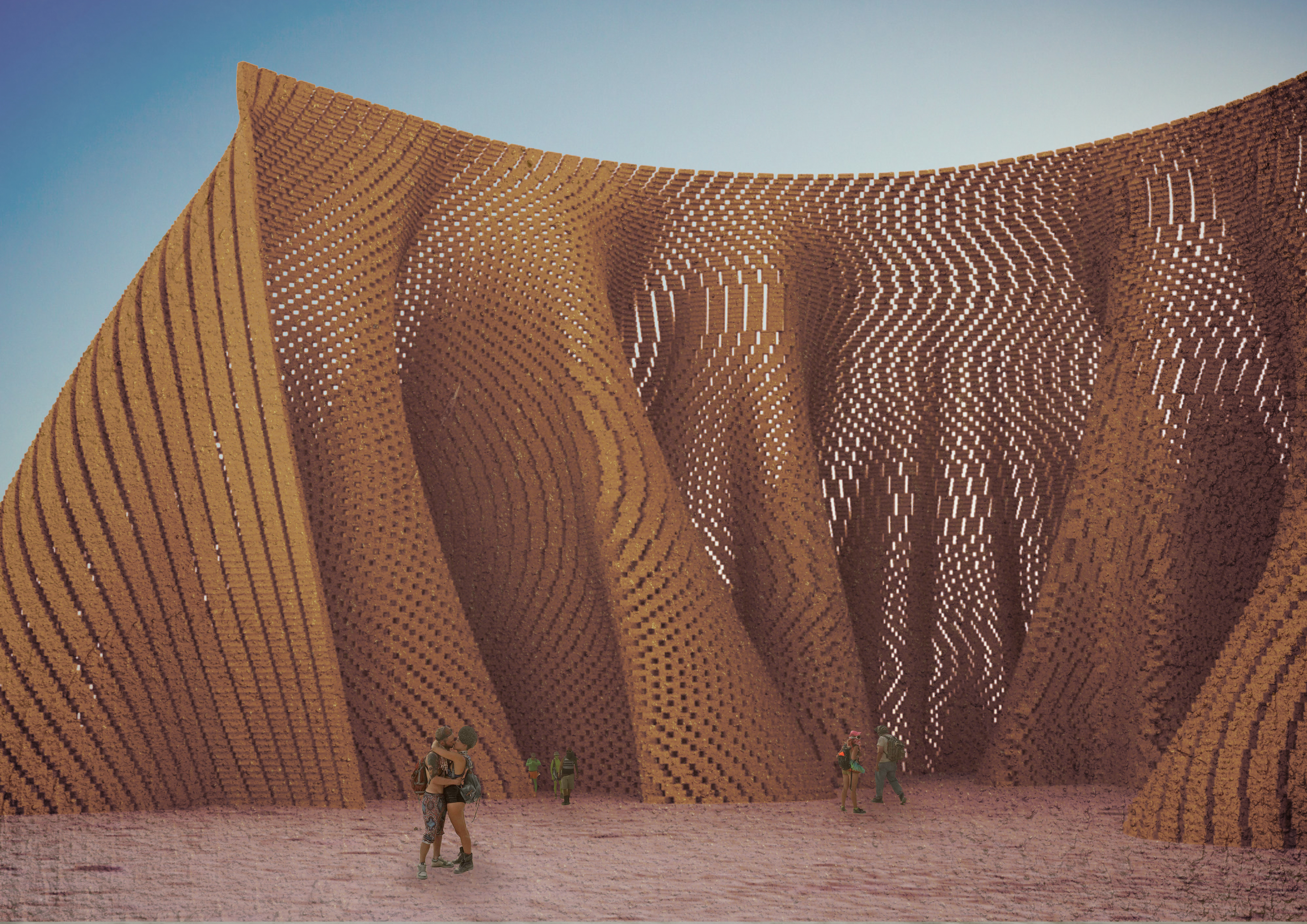
dis|integration[loops]
![disintegration[loops]_a](https://wewanttolearn.files.wordpress.com/2017/11/disintegrationloops_a.jpg)
dis/integration[loops], inspired by the composer William Basinski’s seminal works of the same name, explores the limitations of digital processes in our world – and the chaos that can unfold from overreliance on them.
A towering array is assembled from recursive fragments of an inherently destructive process. It explores the tension that exists between the digital and physical realms; challenging an immortal, digital world, the glorious ruin of the analogue realm confronts the perceived perfection of the artificial.
Existing in a state of intended incompleteness, dis/integration[loops] eschews vanity in favour of exhibiting procedural rawness; the power of ruinous accident reveals itself through the tarnishing of idyllic digitalism.
Pressure-laminated plywood modules, form-found through iterative casting experiments, connect to form a pervious, fragmented structure; it’s transcience and impermanence exaggerated as night follows day.

In the same way that Basinski’s fragile recordings were destroyed upon being processed by the human ear, dis/integration[loops] exists in a contented, lush and shimmering state prior to being activated by human presence.
Proximity-controlled LED lighting impregnates the structure. When combined with sounds inspired by those Basinski’s (de)generative process created, this affords a level of animated deconstruction upon activation; visually and sonically, the imperfect presence of humanity causes dis/integration[loops] to be engulfed in chaotic ripples of distortion.
It’s most perfect (yet still decidedly imperfect) state is one in which it lies dormant and peaceful, undiscovered by the presence of people. It experientially disintegrates upon activation.
The fragmented structure exaggerates ever-changing natural light conditions and provides shelter, as well as an intimate, tactile space withi it’s permeable walls.
‘And then as the last crackle faded and the music was no more, I took in my surroundings and looked around at the faces and I was right there with everybody and we were alive.’
dis/integration[loops] is a reminder than everything we encounter eventually falls apart and returns to dust. It challenges the perfect, edited, occularcentrism that blights our social lives, explores the sound of decay, and the beauty that can exist in destruction. It is a meditation on death and loss, and exploration on a theme that some things are better left untouched.
The experience of life – a gradual disintegration – is simultaneously enriched and eroded by the imperfect nature of our encounters; pristine digitalism deserves a tarnished, ruinous quality symbolic of our experiences.
‘and I was right there with everybody and we were alive.’
Life’s First Flicker
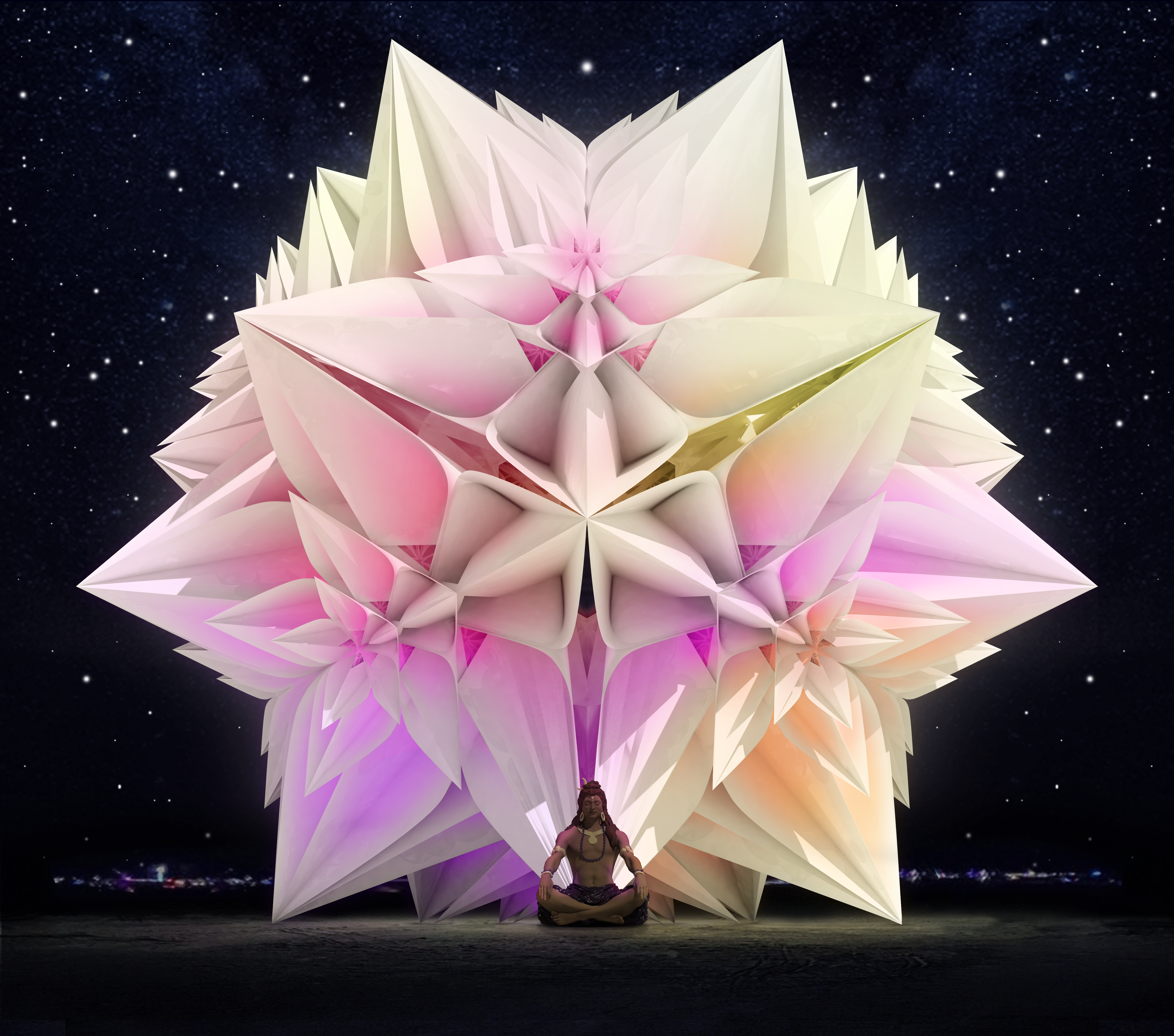
Project Summary
Translucent fractal ball animated by dancing color changing lights symbolizing the very first spark at the beginning of the universe as well as the spark of life that our species is on both an eternal mission to keep alight and is in the final stages of creating anew with artificial intelligence.
Physical Description
A 20 foot diameter translucent form, made of twelve identical five petal polypropylene origami flowers arranged as a dodecahedron each with two smaller flower at their centers and intricately lazercut with a 2d filigree depicting the overall form. All the flowers are tied to each other and to a timber dodecahedral internal skeleton with concealed zip ties. The creased polypropylene held in tension by the origami folds themselves provide the rest of the stability. LED DMX lights sit in the five points which touch the ground, facing upwards, illuminating the entire form.
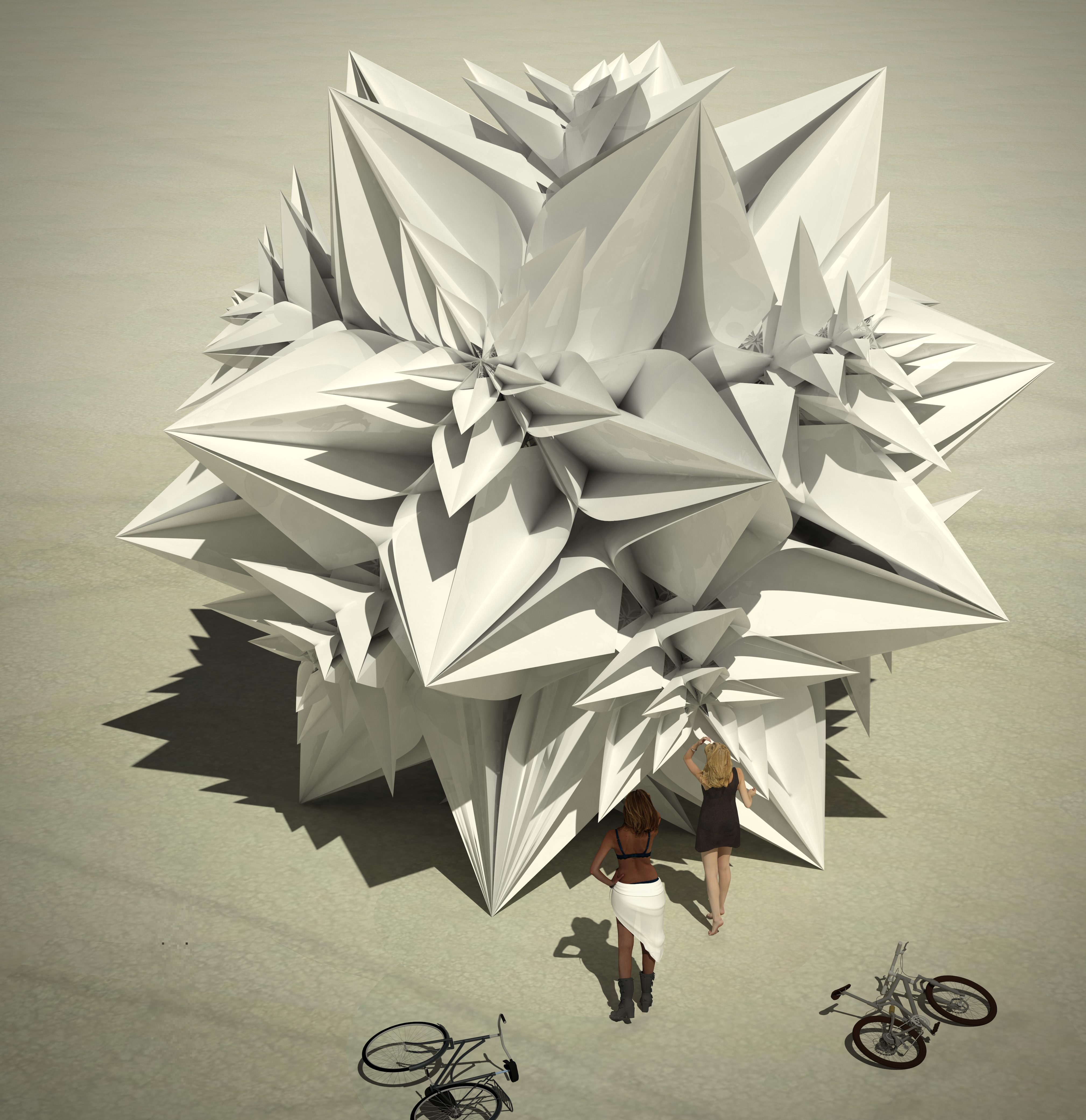
Philosophy
At the end of Isaac Asmiov’s book ‘The last question’ a disembodied AI is the last mark of the human race left in an empty entropic universe. It remains calculating the answer to the last question it was asked, and, unable to find a recipient for it’s solution it says ‘Let there be light’ and creation begins again.
This piece is shaped as a tangible interpretation of this spark. The spark at the first second of the universe and the spark of life which our civilization is racing to create in a sentient self learning AI. This moment, when our creations become self aware, is the theme of burning man 2018 and also likely to be the most important moment in our species’ history. Self teaching AI will rapidly become so powerful it will effectively be a deity. This pavilion’s purpose is to draw the visitors attention to this rapidly approaching moment and consider how we should design this mind before it is too late.
Burners can pass by or play with the spark and think it is just a cool shape, but those who climb up inside what is figuratively a snapshot right at the beginning of new life and the universe, can take a moment to pause and ponder from within, whether their life’s endeavor is relevant in the face of coming AI, what our species’ current knowledge may lack and how it could be codified and explained to a machine and how lucky we are as a generation to have both been born late enough to see AI’s birth, and early enough to have known life before it.
<p><a href=”https://vimeo.com/244593633″>Life’s First Flicker: Burning Man 2018 Art proposal</a> from <a href=”https://vimeo.com/user71835996″>Benjamin Street</a> on <a href=”https://vimeo.com”>Vimeo</a>.</p>
The beauty of error

As our studio dipped into the complexity of fractals, it became easy to get lost. Suddenly, these geometries were everywhere. Trees, clouds, coastlines, our own bodies – all examples of fractals. Systems, that are made up of smaller self-simular parts until they reach infinity. Systems, that travel between dimension (more about it here https://wewanttolearn.wordpress.com/2017/10/18/shapes-fractals-time-the-dimensions-they-belong-to/). Wanting to understand these geometries better, I found a Fractal plugin for Grasshopper by albertovalis on Food4Rhino. Playing around with various parameters and GH components gave me interesting shapes, but which seemed far away from an architectural object. I then decided to give it a try and allow the program to randomly select elements by assigning different true/false patterns. Finally, an error happened and it was beautiful.
Error 101
Summary
Error 101 is a visual representation of relationships between machines and humans. It illustrates what we can learn from each other (what does this mean?). The geometry was generated through a combination of fractal mathematics properties, parametric design tools and finally a computer error, which were all guided by human decisions.
Physical description
The artwork will be made out of ‘chaotically’ arranged ribbons that, together, form a tetrahedron. From far, the geometry will look well defined – a triangle or pyramid. As you get closer you notice the complexity. When you experience is physically, you find logic in the chaos. Inside the tetrahedron is a void.
Error 101 will be constructed using bent cross-laminated timber modules that are interlocked together with flitch plates. Their arrangement will allow the object to be self-supporting. The whole piece is 18’x18’x18’ (5.5 metres). Timber strips create the outer shell and are 25 inches wide (635 mm). Their surface will be treated to achieve a smooth finish to protect both the piece and visitors. Light strips will be fixed to edges of timber curves and turned on at night. Assembly will be completed on site.
Interactivity and Mission
Error 101 is left open to interpretation – everyone can have their personal take on the piece. Visual and emotional perception of Error 101 may change depending on how close you get to it. It may encourage visitors to think of it, as something that travels between dimensions, which is a liberating allegory of how one thing can become another and how the whole is just a collection of its parts. Just like water can be liquid, ice or vapor, Error 101 can be a triangle, pyramid or chaotic curves.
The structure is climbable and each of many unique curves can be treated as a nest. Occupying empty spaces on different levels may make burners feel like a part of the ‘chaos’, that has a space for everyone. Different curvature can suggest different positioning of a body that may influence visual as well as physical experience. Entering the structure’s core shifts the visitor’s focus away from the idea of a pyramid and allows them to focus on what’s within. Such study erases preconceptions and allows new ideas to be born. This notion is also enhanced with the use of lights at night.
Philosophy
Error 101 is a product of human ability to perceive beauty, and computer’s power to process complex mathematics. Its development started with an attempt to try to understand fractal geometries that only became possible to study in the recent years due to the development of computer processing power. A continuous human-computer-human processes that involved both logic and error allowed for the piece to be born.
Error 101 is a common error in Internet browsing. A simple solution to it is clearing browsing history and cache. It may also appear in other spheres of digital world when software or a device is out of date. Burning Man participants are invited to clear their mind, update the ‘software’ and reset their system to become a new advanced version of themselves. The final steps of error 101 creation involved chance and error. The chaos led to something beautiful. We, as humans, can learn from this – learn to let go, to acknowledge and even appreciate mistakes, complexity of the world and our own selves. The geometry of an artwork is essentially a continuous strip that can be unrolled into one flat curve on the ground. This idea of continuity and interdependence is an allegory of a world’s structure.
The closer you get to Error 101, the more you can learn from it. A 2D triangle turns into 3D pyramid and then into a collection of overlaying shapes that are not truly from our dimension. With the speed of the modern world we tend to simplify things, which leads to inability to see details. Visitors are invited to come take time to study and appreciate the complexity of the Error, and to realize the beauty of a whole. From this, they may find that, in fact, all processes in our lives have a similar structure. Chaos generates order and order generates chaos.

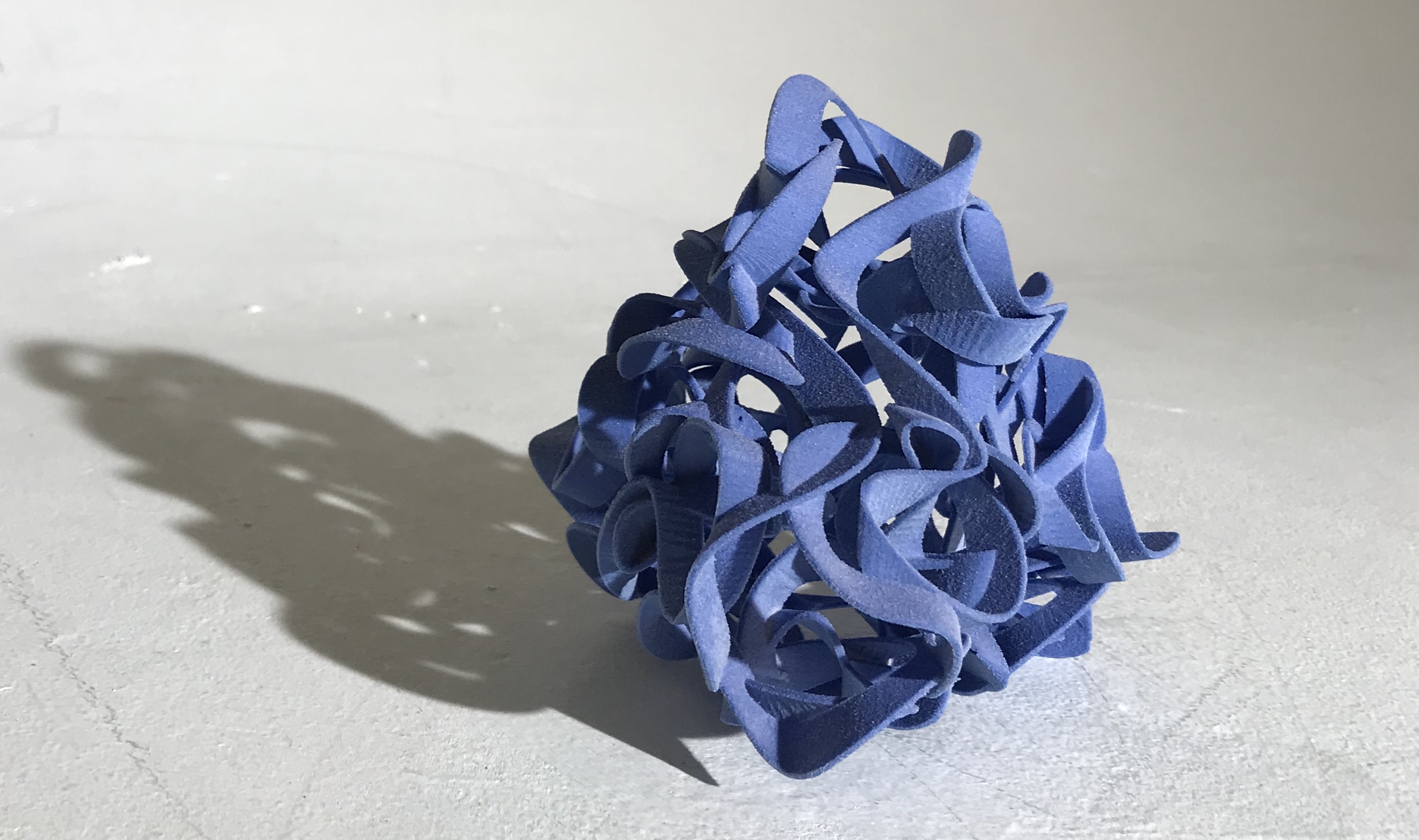
Babels
Symbol- Language and Sound into System
Language has a strong symbolic meaning to the mankind. It is not just a sound but with meanings which then allows to self-express, communicate and inspire. The mechanism of the sound system of languages is translated into visually represented geometries using Chladni’s Law.

3-Dimensional computer generated Chladni Patterns
When the frequencies increase, the pattern gets more complicated.
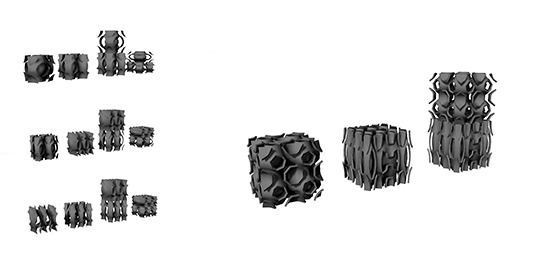
 Tower of Babel – The origin of different languages
Tower of Babel – The origin of different languages
“Come, let’s make bricks and bake them thoroughly. […] Come let us build ourselves a city, with a tower that reaches to the heavens, so that we may make a name for ourselves and not be scattered over the face of the whole earth.” (Genesis 11:3~4)
(The Tower of Babel by Pieter Bruegel)
It is the story from the Bible but also architectural structure found in Mesopotamia Civilisation – called Ziggurat. It was made of asphalt and baked bricks with total dimensions of 90m x 90m, 90m high. This is equivalent 30th floor building.
The united humanity spoke a single language and agreed to build a city and a tower that is ‘tall enough to reach heaven’. God found such behaviour as rude and disrespectful. He confounded man’s speech so that they could no longer understand each other.
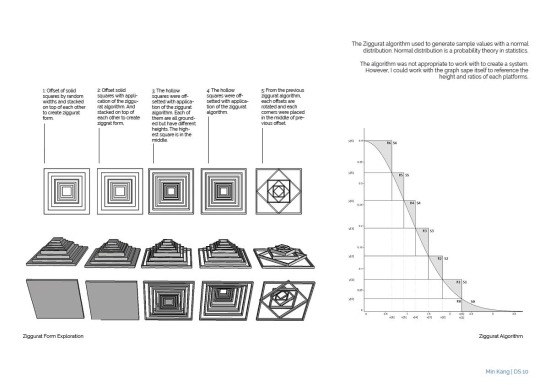
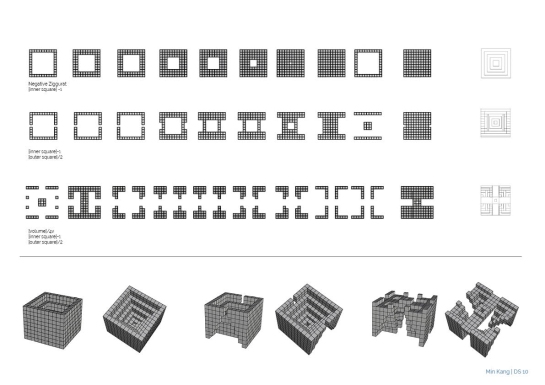
Concept Development through systematic studies of Ziggurat
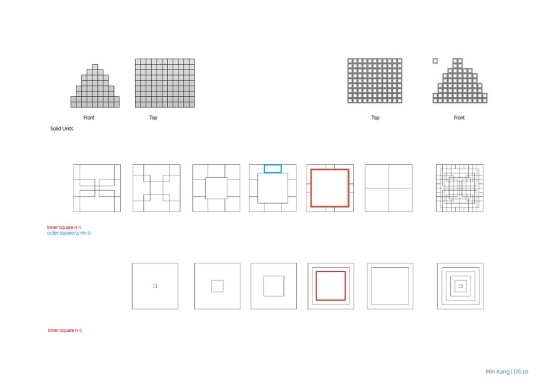
The frequency and nodes of the word is analysed and recreated as two geometrical forms. They are proportioned according to the Ziggurat Algorithm ratio and timber pieces are stacked up vertically reaching the highest deck at 8m above. The structure encourages to climb complex geometry.
While reaching the top, less intense the space becomes. The LEDs are placed underneath the timber pieces which are concentrated on the top of the tower and scattered following the central void of the structure. Lights illuminate with the voice reactive sensor placed at the top of the tower.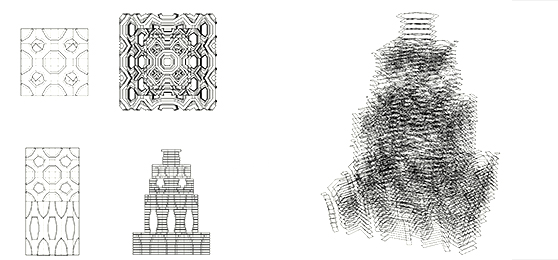
Human always wanted to reach higher points either physical or spiritual. The height of architecture symbolised one’s power and control. This can be observed from the tower of Babel and continues in architectural history. Such expression of the desire of heights lead to competition of building higher structure.
High rise buildings were often found in religious architecture where they had few typical characteristics. First, it was the only tower to observe your land and the only tower which can be seen from everywhere in town. It has a visual meaning that the land within the perspective is the land within control. Second, religious architecture often had music instruments embedded within. This represented the control of the land where music reaches. And finally, high-rise tower was a representation of the centre of universe and sacred space in religious term. The tower, architecture of height is a spatial symbol of man’s deep desires.
The ritual is all about finding the true desire of your own. This begins with constructing the tower where the ritual follows the biblical story of Babel. Climbing up 8m high construct is a challenge then the climbers are rewarded with the beautiful panoramic view of Black Rock city. The climbers will also interact with the installation by continuously stacking up the Babels with anything they can find. Eventually it will deform from the original shape. Then the Babels will be the collective symbol of the Burners’ pure desire.

